JavaScript seems to be disabled in your browser. For the best experience on our site, be sure to turn on Javascript in your browser.
- Create an Account
- For Schools
- For Retailers
- Drop down option
- Compare Products

Critical Thinking Skills Book 2
Download sample pages.
For selective school tests, opportunity class tests and problem solving
Critical Thinking Skills Book 2 introduces students to a very wide range of logical reasoning questions, many of which will excite and challenge through their novelty and creativity. The use of visual stimulus is important here as it tests interpretation skills as well as the application of rules to situations. The capacity to apply thinking in iterative ways is also tested in this book as there are several different questions for many single-stimulus items. This has been purposefully incorporated in order to extend and build critical thinking skills as a demonstration of fluid intelligence.
Each book includes fully worked solutions to all questions.
About the Author
Mohan Dhall is an experienced teacher and teacher-educator, author and educational manager. Trained in gifted education, Mohan has developed many critical thinking courses for students and has also trained teachers in critical and creative thinking skills. As Director, he ran one of Australia’s longest running school based centres for gifted children. He has written hundreds of different types of critical thinking questions and had more than 70 books published. Mohan is currently the Academic Leader of M2K Education and Advisory.
| Year Level | Year 4, Year 5, Year 6 |
|---|---|
| Edition | 1st |
| Date of Publication | August 2021 |
| ISBN | 9781760324070 |
| Subject | General Ability (IQ) |
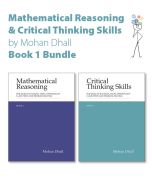
- NONFICTION BOOKS
- BEST NONFICTION 2023
- BEST NONFICTION 2024
- Historical Biographies
- The Best Memoirs and Autobiographies
- Philosophical Biographies
- World War 2
- World History
- American History
- British History
- Chinese History
- Russian History
- Ancient History (up to 500)
- Medieval History (500-1400)
- Military History
- Art History
- Travel Books
- Ancient Philosophy
- Contemporary Philosophy
- Ethics & Moral Philosophy
- Great Philosophers
- Social & Political Philosophy
- Classical Studies
- New Science Books
- Maths & Statistics
- Popular Science
- Physics Books
- Climate Change Books
- How to Write
- English Grammar & Usage
- Books for Learning Languages
- Linguistics
- Political Ideologies
- Foreign Policy & International Relations
- American Politics
- British Politics
- Religious History Books
- Mental Health
- Neuroscience
- Child Psychology
- Film & Cinema
- Opera & Classical Music
- Behavioural Economics
- Development Economics
- Economic History
- Financial Crisis
- World Economies
- Investing Books
- Artificial Intelligence/AI Books
- Data Science Books
- Sex & Sexuality
- Death & Dying
- Food & Cooking
- Sports, Games & Hobbies
- FICTION BOOKS
- BEST NOVELS 2024
- BEST FICTION 2023
- New Literary Fiction
- World Literature
- Literary Criticism
- Literary Figures
- Classic English Literature
- American Literature
- Comics & Graphic Novels
- Fairy Tales & Mythology
- Historical Fiction
- Crime Novels
- Science Fiction
- Short Stories
- South Africa
- United States
- Arctic & Antarctica
- Afghanistan
- Myanmar (Formerly Burma)
- Netherlands
- Kids Recommend Books for Kids
- High School Teachers Recommendations
- Prizewinning Kids' Books
- Popular Series Books for Kids
- BEST BOOKS FOR KIDS (ALL AGES)
- Ages Baby-2
- Books for Teens and Young Adults
- THE BEST SCIENCE BOOKS FOR KIDS
- BEST KIDS' BOOKS OF 2023
- BEST BOOKS FOR TEENS OF 2023
- Best Audiobooks for Kids
- Environment
- Best Books for Teens of 2023
- Best Kids' Books of 2023
- Political Novels
- New History Books
- New Historical Fiction
- New Biography
- New Memoirs
- New World Literature
- New Economics Books
- New Climate Books
- New Math Books
- New Philosophy Books
- New Psychology Books
- New Physics Books
- THE BEST AUDIOBOOKS
- Actors Read Great Books
- Books Narrated by Their Authors
- Best Audiobook Thrillers
- Best History Audiobooks
- Nobel Literature Prize
- Booker Prize (fiction)
- Baillie Gifford Prize (nonfiction)
- Financial Times (nonfiction)
- Wolfson Prize (history)
- Royal Society (science)
- Pushkin House Prize (Russia)
- Walter Scott Prize (historical fiction)
- Arthur C Clarke Prize (sci fi)
- The Hugos (sci fi & fantasy)
- Audie Awards (audiobooks)
Make Your Own List
Nonfiction Books » Philosophy Books
The best books on critical thinking, recommended by nigel warburton.

Thinking from A to Z by Nigel Warburton
Do you know your straw man arguments from your weasel words? Nigel Warburton , Five Books philosophy editor and author of Thinking from A to Z, selects some of the best books on critical thinking—and explains how they will help us make better-informed decisions and construct more valid arguments.
Interview by Cal Flyn , Deputy Editor
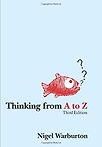
Thinking, Fast and Slow by Daniel Kahneman
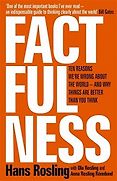
Factfulness: Ten Reasons We're Wrong About The World — And Why Things Are Better Than You Think by Hans Rosling
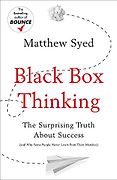
Black Box Thinking: The Surprising Truth About Success by Matthew Syed
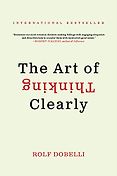
The Art of Thinking Clearly by Rolf Dobelli
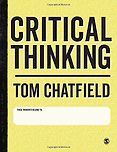
Critical Thinking: Your Guide to Effective Argument, Successful Analysis and Independent Study by Tom Chatfield
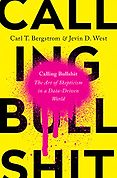
Calling Bullshit: The Art of Skepticism in a Data-Driven World by Carl Bergstrom & Jevin West
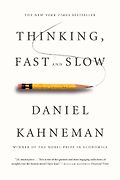
1 Thinking, Fast and Slow by Daniel Kahneman
2 factfulness: ten reasons we're wrong about the world — and why things are better than you think by hans rosling, 3 black box thinking: the surprising truth about success by matthew syed, 4 the art of thinking clearly by rolf dobelli, 5 critical thinking: your guide to effective argument, successful analysis and independent study by tom chatfield, 6 calling bullshit: the art of skepticism in a data-driven world by carl bergstrom & jevin west.
W e’re here to talk about critical thinking. Before we discuss your book recommendations, I wonder if you would first explain: What exactly is critical thinking, and when should we be using it?
But that’s just one element of critical thinking. Critical thinking is broader, though it encompasses that. In recent years, it’s been very common to include discussion of cognitive biases—the psychological mistakes we make in reasoning and the tendencies we have to think in certain patterns which don’t give us reliably good results. That’s another aspect: focussing on the cognitive biases is a part of what’s sometimes called ‘informal logic’, the sorts of reasoning errors that people make, which can be described as fallacious. They’re not, strictly speaking, logical fallacies, always. Some of them are simply psychological tendencies that give us unreliable results.
The gambler’s fallacy is a famous one: somebody throwing a die that isn’t loaded has thrown it three times without getting a six, and then imagines that, by some kind of law of averages, the fourth time they’re more likely to get a six, because they haven’t yet got one yet. That’s just a bad kind of reasoning, because each time that you roll the dice, the odds are the same: there’s a one in six chance of throwing a six. There’s no cumulative effect and a dice doesn’t have a memory. But we have this tendency, or certainly gamblers often do, to think that somehow the world will even things out and give you a win if you’ve had a series of losses. That’s a kind of informal reasoning error that many of us make, and there are lots of examples like that.
I wrote a little book called Thinking from A to Z which was meant to name and explain a whole series of moves and mistakes in thinking. I included logic, some cognitive biases, some rhetorical moves, and also (for instance) the topic of pseudo-profundity, whereby people make seemingly deep statements that are in fact shallow. The classical example is to give a seeming paradox—to say, for example ‘knowledge is just a kind of ignorance,’ or ‘virtue is only achieved through vice.’ Actually, that’s just a rhetorical trick, and once you see it, you can generate any number of such ‘profundities’. I suppose that would fall under rhetoric, the art of persuasion: persuading people that you are a deeper thinker than you are. Good reasoning isn’t necessarily the best way to persuade somebody of something, and there are many devious tricks that people use within discussion to persuade people of a particular position. The critical thinker is someone who recognises the moves, can anatomise the arguments, and call them to attention.
So, in answer to your question: critical thinking is not just pure logic . It’s a cluster of things. But its aim is to be clear about what is being argued, what follows from the given evidence and arguments, and to detect any cognitive biases or rhetorical moves that may lead us astray.
Many of the terms you define and illustrate in Thinking from A to Z— things like ‘straw man’ arguments and ‘weasel words’—have been creeping into general usage. I see them thrown around on Twitter. Do you think that our increased familiarity with debate, thanks to platforms like Twitter, has improved people’s critical thinking or made it worse?
I think that improving your critical thinking can be quite difficult. But one of the ways of doing it is to have memorable labels, which can describe the kind of move that somebody’s making, or the kind of reasoning error, or the kind of persuasive technique they’re using.
For example, you can step back from a particular case and see that somebody’s using a ‘weak analogy’. Once you’re familiar with the notion of a weak analogy, it’s a term that you can use to draw attention to a comparison between two things which aren’t actually alike in the respects that somebody is implying they are. Then the next move of a critical thinker would be to point out the respects in which this analogy doesn’t hold, and so demonstrate how poor it is at supporting the conclusion provided. Or, to use the example of weasel words—once you know that concept, it’s easier to spot them and to speak about them.
Social media, particularly Twitter, is quite combative. People are often looking for critical angles on things that people have said, and you’re limited in words. I suspect that labels are probably in use there as a form of shorthand. As long as they’re used in a precise way, this can be a good thing. But remember that responding to someone’s argument with ‘that’s a fallacy’, without actually spelling out what sort of fallacy it is supposed to be, is a form of dismissive rhetoric itself.
There are also a huge number of resources online now which allow people to discover definitions of critical thinking terms. When I first wrote Thinking from A to Z , there weren’t the same number of resources available. I wrote it in ‘A to Z’ form, partly just as a fun device that allows for lots of cross references, but partly because I wanted to draw attention to the names of things. Naming the moves is important.
“People seem to get a kick out of the idea of sharing irrelevant features—it might be a birthday or it might be a hometown—with somebody famous. But so what?”
The process of writing the book improved my critical thinking quite a lot, because I had to think more precisely about what particular terms meant and find examples of them that were unambiguous. That was the hardest thing, to find clear-cut examples of the various moves, to illustrate them. I coined some of the names myself: there’s one in there which is called the ‘Van Gogh fallacy,’ which is the pattern of thought when people say: ‘Well, Van Gogh had red hair, was a bit crazy, was left-handed, was born on the 30th of March, and, what do you know, I share all those things’—which I do happen to do—‘and therefore I must be a great genius too.’
I love that. Well, another title that deals with psychological biases is the first critical thinking book that you want to discuss, Daniel Kahneman’s Thinking Fast and Slow . Why did you choose this one?
This is an international bestseller by the Nobel Prize-winning behavioural economist—although he’s principally a psychologist—Daniel Kahneman. He developed research with Amos Tversky, who unfortunately died young. I think it would have been a co-written book otherwise. It’s a brilliant book that summarizes their psychological research on cognitive biases (or its patterns of thinking) which all of us are prone to, which aren’t reliable.
There is a huge amount of detail in the book. It summarizes a lifetime of research—two lifetimes, really. But Kahneman is very clear about the way he describes patterns of thought: as using either ‘System One’ or ‘System Two.’ System One is the fast, intuitive, emotional response to situations where we jump to a conclusion very quickly. You know: 2 + 2 is 4. You don’t think about it.
System Two is more analytical, conscious, slower, methodical, deliberative. A more logical process, which is much more energy consuming. We stop and think. How would you answer 27 × 17? You’d have to think really hard, and do a calculation using the System Two kind of thinking. The problem is that we rely on this System One—this almost instinctive response to situations—and often come out with bad answers as a result. That’s a framework within which a lot of his analysis is set.
I chose this book because it’s a good read, and it’s a book you can keep coming back to—but also because it’s written by a very important researcher in the area. So it’s got the authority of the person who did the actual psychological research. But it’s got some great descriptions of the phenomena he researches, I think. Anchoring, for instance. Do you know about anchoring?
I think so. Is that when you provide an initial example that shapes future responses? Perhaps you’d better explain it.
That’s more or less it. If you present somebody with an arbitrary number, psychologically, most people seem prone when you ask them a question to move in the direction of that number. For instance, there’s an experiment with judges. They were being asked off the cuff: What would be a good sentence for a particular crime, say shoplifting? Maybe they’d say it would be a six-month sentence for a persistent shoplifter.
But if you prime a judge by giving an anchoring number—if you ask, ‘Should the sentence for shoplifting be more than nine months?’ They’re more like to say on average that the sentence should be eight months than they would have been otherwise. And if you say, ‘Should it be punished by a sentence of longer than three months?’ they’re more likely to come down in the area of five , than they would otherwise.
So the way you phrase a question, by introducing these numbers, you give an anchoring effect. It sways people’s thinking towards that number. If you ask people if Gandhi was older than 114 years old when he died, people give a higher answer than if you just asked them: ‘How old was Gandhi when he died?’
I’ve heard this discussed in the context of charity donations. Asking if people will donate, say, £20 a month returns a higher average pledge than asking for £1 a month.
People use this anchoring technique often with selling wine on a list too. If there’s a higher-priced wine for £75, then somehow people are more drawn to one that costs £40 than they would otherwise have been. If that was the most expensive one on the menu, they wouldn’t have been drawn to the £40 bottle, but just having seen the higher price, they seem to be drawn to a higher number. This phenomenon occurs in many areas.
And there are so many things that Kahneman covers. There’s the sunk cost fallacy, this tendency that we have when we give our energy, or money, or time to a project—we’re very reluctant to stop, even when it’s irrational to carry on. You see this a lot in descriptions of withdrawal from war situations. We say: ‘We’ve given all those people’s lives, all that money, surely we’re not going to stop this campaign now.’ But it might be the rational thing to do. All that money being thrown there, doesn’t mean that throwing more in that direction will get a good result. It seems that we have a fear of future regret that outweighs everything else. This dominates our thinking.
Support Five Books
Five Books interviews are expensive to produce. If you're enjoying this interview, please support us by donating a small amount .
What Kahneman emphasizes is that System One thinking produces overconfidence based on what’s often an erroneous assessment of a situation. All of us are subject to these cognitive biases, and that they’re extremely difficult to remove. Kahneman’s a deeply pessimistic thinker in some respects; he recognizes that even after years of studying these phenomena he can’t eliminate them from his own thinking. I interviewed him for a podcast once , and said to him: ‘Surely, if you teach people critical thinking, they can get better at eliminating some of these biases.’ He was not optimistic about that. I’m much more optimistic than him. I don’t know whether he had empirical evidence to back that up, about whether studying critical thinking can increase your thinking abilities. But I was surprised how pessimistic he was.
Interesting.
Unlike some of the other authors that we’re going to discuss . . .
Staying on Kahneman for a moment, you mentioned that he’d won a Nobel Prize, not for his research in psychology per se but for his influence on the field of economics . His and Tversky’s ground-breaking work on the irrationality of human behaviour and thinking forms the spine of a new field.
Let’s look at Hans Rosling’s book next, this is Factfulness . What does it tell us about critical thinking?
Rosling was a Swedish statistician and physician, who, amongst other things, gave some very popular TED talks . His book Factfulness , which was published posthumously—his son and daughter-in-law completed the book—is very optimistic, so completely different in tone from Kahneman’s. But he focuses in a similar way on the ways that people make mistakes.
We make mistakes, classically, in being overly pessimistic about things that are changing in the world. In one of Rosling’s examples he asks what percentage of the world population is living on less than $2 a day. People almost always overestimate that number, and also the direction in which things are moving, and the speed in which they’re moving. Actually, in 1966, half of the world’s population was in extreme poverty by that measure, but by 2017 it was only 9%, so there’s been a dramatic reduction in global poverty. But most people don’t realise this because they don’t focus on the facts, and are possibly influenced by what they may have known about the situation in the 1960s.
If people are asked what percentage of children are vaccinated against common diseases, they almost always underestimate it. The correct answer is a very high proportion, something like 80%. Ask people what the life expectancy for every child born today is, the global average, and again they get it wrong. It’s over 70 now, another surprisingly high figure. What Rosling’s done as a statistician is he’s looked carefully at the way the world is.
“Pessimists tend not to notice changes for the better”
People assume that the present is like the past, so when they’ve learnt something about the state of world poverty or they’ve learnt about health, they often neglect to take a second reading and see the direction in which things are moving, and the speed with which things are changing. That’s the message of this book.
It’s an interesting book; it’s very challenging. It may be over-optimistic. But it does have this startling effect on the readers of challenging widely held assumptions, much as Steven Pinker ‘s The Better Angels of Our Nature has done. It’s a plea to look at the empirical data, and not just assume that you know how things are now. But pessimists tend not to notice changes for the better. In many ways, though clearly not in relation to global warming and climate catastrophe, the statistics are actually very good for humanity.
That’s reassuring.
So this is critical thinking of a numerical, statistical kind. It’s a bit different from the more verbally-based critical thinking that I’ve been involved with. I’m really interested to have my my assumptions challenged, and Factfulness is a very readable book. It’s lively and thought-provoking.
Coming back to what you said about formal logic earlier, statistics is another dense subject which needs specialist training. But it’s one that has a lot in common with critical thinking and a lot of people find very difficult—by which I mean, it’s often counter-intuitive.
One of the big problems for an ordinary reader looking at this kind of book is that we are not equipped to judge the reliability of his sources, and so the reliability of the conclusions that he draws. I think we have to take it on trust and authority and hope that, given the division of intellectual labour, there are other statisticians looking at his work and seeing whether he was actually justified in drawing the conclusions that he drew. He made these sorts of public pronouncements for a long time and responded to critics.
But you’re right that there is a problem here. I believe that most people can equip themselves with tools for critical thinking that work in everyday life. They can learn something about cognitive biases; they can learn about reasoning and rhetoric, and I believe that we can put ourselves as members of a democracy in a position where we think critically about the evidence and arguments that are being presented to us, politically and in the press. That should be open to all intelligent people, I think. It is not a particularly onerous task to equip yourself with a basic tools of thinking clearly.
Absolutely. Next you wanted to talk about Five Books alumnus Matthew Syed ‘s Black Box Thinking .
Yes, quite a different book. Matthew Syed is famous as a former international table tennis player, but—most people probably don’t know this—he has a first-class degree in Philosophy, Politics and Economics (PPE) from Oxford as well.
This book is really interesting. It’s an invitation to think differently about failure. The title, Black Box Thinking, comes from the black boxes which are standardly included in every passenger aircraft, so that if an accident occurs there’s a recording of the flight data and a recording of the audio communications as the plane goes down. When there’s a crash, rescuers always aim to recover these two black boxes. The data is then analysed, the causes of the crash, dissected and scrutinized, and the information shared across the aeronautic industry and beyond.
Obviously, everybody wants to avoid aviation disasters because they’re so costly in terms of loss of human life. They undermine trust in the whole industry. There’s almost always some kind of technical or human error that can be identified, and everybody can learn from particular crashes. This is a model of an industry where, when there is a failure, it’s treated as a very significant learning experience, with the result that airline travel has become a very safe form of transport.
This contrasts with some other areas of human endeavour, such as, sadly, much of healthcare, where the information about failures often isn’t widely shared. This can be for a number of reasons: there may be a fear of litigation—so if a surgeon does something unorthodox, or makes a mistake, and somebody as a result doesn’t survive an operation, the details of exactly what happened on the operating table will not be widely shared, typically, because there is this great fear of legal comeback.
The hierarchical aspects of the medical profession may have a part to play here, too. People higher up in the profession are able to keep a closed book, and not share their mistakes with others, because it might be damaging to their careers for people to know about their errors. There has been, historically anyway, a tendency for medical negligence and medical error, to be kept very quiet, kept hidden, hard to investigate.
“You can never fully confirm an empirical hypothesis, but you can refute one by finding a single piece of evidence against it”
What Matthew Syed is arguing is that we need to take a different attitude to failure and see it as the aviation industry does. He’s particularly interested in this being done within the healthcare field, but more broadly too. It’s an idea that’s come partly from his reading of the philosopher Karl Popper, who described how science progresses not by proving theories true, but by trying to disprove them. You can never fully confirm an empirical hypothesis, but you can refute one by finding a single piece of evidence against it. So, in a sense, the failure of the hypothesis is the way by which science progresses: conjecture followed by refutation, not hypothesis followed by confirmation.
As Syed argues, we progress in all kinds of areas is by making mistakes. He was a superb table-tennis player, and he knows that every mistake that he made was a learning experience, at least potentially, a chance to improve. I think you’d find the same attitude among musicians, or in areas where practitioners are very attentive to the mistakes that they make, and how those failures can teach them in a way that allows them to make a leap forward. The book has a whole range of examples, many from industry, about how different ways of thinking about failure can improve the process and the output of particular practices.
When we think of bringing up kids to succeed, and put emphasis on avoiding failure, we may not be helping them develop. Syed’s argument is that we should make failure a more positive experience, rather than treat it as something that’s terrifying, and always to be shied away from. If you’re trying to achieve success, and you think, ‘I have to achieve that by accumulating other successes,’ perhaps that’s the wrong mindset to achieve success at the higher levels. Perhaps you need to think, ‘Okay, I’m going to make some mistakes, how can I learn from this, how can I share these mistakes, and how can other people learn from them too?’
That’s interesting. In fact, just yesterday I was discussing a book by Atul Gawande, the surgeon and New Yorker writer, called The Checklist Manifesto . In that, Gawande also argues that we should draw from the success of aviation, in that case, the checklists that they run through before take-off and so on, and apply it to other fields like medicine. A system like this is aiming to get rid of human error, and I suppose that’s what critical thinking tries to do, too: rid us of the gremlins in machine.
Well, it’s also acknowledging that when you make an error, it can have disastrous consequence. But you don’t eliminate errors just by pretending they didn’t occur. With the Chernobyl disaster , for instance, there was an initial unwillingness to accept the evidence in front of people’s eyes that a disaster had occurred, combined with a fear of being seen to have messed up. There’s that tendency to think that everything’s going well, a kind of cognitive bias towards optimism and a fear of being responsible for error, but it’s also this unwillingness to see that in certain areas, admission of failure and sharing of the knowledge that mistakes have occurred is the best way to minimize failure in the future.
Very Beckettian . “Fail again. Fail better.”
Absolutely. Well, shall we move onto to Rolf Dobelli’s 2013 book, The Art of Thinking Clearly ?
Yes. This is quite a light book in comparison with the others. It’s really a summary of 99 moves in thinking, some of them psychological, some of them logical, some of them social. What I like about it is that he uses lots of examples. Each of the 99 entries is pretty short, and it’s the kind of book you can dip into. I would think it would be very indigestible to read it from cover to cover, but it’s a book to keep going back to.
I included it because it suggests you can you improve your critical thinking by having labels for things, recognising the moves, but also by having examples which are memorable, through which you can learn. This is an unpretentious book. Dobelli doesn’t claim to be an original thinker himself; he’s a summariser of other people’s thoughts. What he’s done is brought lots of different things together in one place.
Just to give a flavour of the book: he’s got a chapter on the paradox of choice that’s three pages long called ‘Less is More,’ and it’s the very simple idea that if you present somebody with too many choices, rather than freeing them and improving their life and making them happier, it wastes a lot of their time, even destroys the quality of their life.
“If you present somebody with too many choices, it wastes a lot of their time”
I saw an example of this the other day in the supermarket. I bumped into a friend who was standing in front of about 20 different types of coffee. The type that he usually buys wasn’t available, and he was just frozen in this inability to make a decision between all the other brands that were in front of him. If there’d only been one or two, he’d have just gone for one of those quickly.
Dobelli here is summarising the work of psychologist Barry Schwartz who concluded that generally, a broader selection leads people to make poorer decisions for themselves. We think going into the world that what we need is more choice, because that’ll allow us to do the thing we want to do, acquire just the right consumable, or whatever. But perhaps just raising that possibility, the increased number of choices will lead us to make poorer choices than if we had fewer to choose between.
Now, that’s the descriptive bit, but at the end of this short summary, he asks ‘So what can you do about this practically?’ His answer is that you should think carefully about what you want before you look at what’s on offer. Write down the things you think you want and stick to them. Don’t let yourself be swayed by further choices. And don’t get caught up in a kind of irrational perfectionism. This is not profound advice, but it’s stimulating. And that’s typical of the book.
You can flip through these entries and you can take them or leave them. It’s a kind of self-help manual.
Oh, I love that. A critical thinking self-help book .
It really is in that self-help genre, and it’s nicely done. He gets in and out in a couple of pages for each of these. I wouldn’t expect this to be on a philosophy reading list or anything like that, but it’s been an international bestseller. It’s a clever book, and I think it’s definitely worth dipping into and coming back to. The author is not claiming that it is the greatest or most original book in the world; rather, it’s just a book that’s going to help you think clearly. That’s the point.
Absolutely. Let’s move to the final title, Tom Chatfield’s Critical Thinking: Your Guide to Effective Argument, Successful Analysis and Independent Study . We had Tom on Five Books many moons ago to discuss books about computer games . This is rather different. What makes it so good?
Well, this is a different kind of book. I was trying to think about somebody reading this interview who wants to improve their thinking. Of the books I’ve discussed, the ones that are most obviously aimed at that are Black Box Thinking , the Dobelli book, and Tom Chatfield’s Critical Thinking . The others are more descriptive or academic. But this book is quite a contrast with the Dobelli’s. The Art of Thinking Clearly is a very short and punchy book, while Tom’s is longer, and more of a textbook. It includes exercises, with summaries in the margins, it’s printed in textbook format. But that shouldn’t put a general reader off, because I think it’s the kind of thing you can work through yourself and dip into.
It’s clearly written and accessible, but it is designed to be used on courses as well. Chatfield teaches a point, then asks you to test yourself to see whether you’ve learnt the moves that he’s described. It’s very wide-ranging: it includes material on cognitive biases as well as more logical moves and arguments. His aim is not simply to help you think better, and to structure arguments better, but also to write better. It’s the kind of book that you might expect a good university to present to the whole first year intake, across a whole array of courses. But I’m including it here more as a recommendation for the autodidact. If you want to learn to think better: here is a course in the form of a book. You can work through this on your own.
It’s a contrast with the other books as well, so that’s part of my reason for putting it in there, so there’s a range of books on this list.
Definitely. I think Five Books readers, almost by definition, tend towards autodidacticism, so this is a perfect book recommendation. And, finally, to close: do you think that critical thinking is something that more people should make an effort to learn? I suppose the lack of it might help to explain the rise of post-truth politics.
It’s actually quite difficult to teach critical thinking in isolation. In the Open University’s philosophy department, when I worked there writing and designing course materials, we decided in the end to teach critical thinking as it arose in teaching other content: by stepping back from time to time to look at the critical thinking moves being made by philosophers, and the critical thinking moves a good student might make in response to them. Pedagogically, that often works much better than attempting to teach critical thinking as a separate subject in isolation.
This approach can work in scientific areas too. A friend of mine has run a successful university course for zoologists on critical thinking, looking at correlation and cause, particular types of rhetoric that are used in write ups and experiments, and so on, but all the time driven by real examples from zoology. If you’ve got some subject matter, and you’ve got examples of people reasoning, and you can step back from it, I think this approach can work very well.
But in answer to your question, I think that having some basic critical thinking skills is a prerequisite of being a good citizen in a democracy . If you are too easily swayed by rhetoric, weak at analysing arguments and the ways that people use evidence, and prone to all kinds of biases that you are unaware of, how can you engage politically? So yes, all of us can improve our critical thinking skills, and I do believe that that is an aspect of living the examined life that Socrates was so keen we all should do. [ end of the original interview. Update below ]
———————————-
It’s been just over two years since you explained to us what critical thinking is all about. Could you update us on any books that have come out since we first spoke?
Calling Bullshit by Carl Bergstrom and Jevin West started life as a course at the University of Washington. It is a book—a handbook really—written with the conviction that bullshit, particularly the kind that is circulated on the Internet, is damaging democracy , and that misinformation and disinformation can have very serious consequences. Bullshitters don’t care about truth. But truth is important, and this book shows why. It is focussed on examples from science and medicine, but ranges more widely too. It’s a lively read. It covers not just verbal bullshit, bullshit with statistics (particularly in relation to big data) and about causation, but also has a chapter on bullshit data visualisations that distract from the content they are about, or present that data in misleading ways. Like all good books on critical thinking this one includes some discussion of the psychology of being taken in by misleading contributions to public debate.
In How To Make the World Add Up , Tim Harford gives us ten rules for thinking better about numbers, together with a Golden Rule (‘Be curious’). Anyone who has listened to his long-running radio series More or Less will know how brilliant Tim is at explaining number-based claims – as I read it, I hallucinated Tim’s reassuring, sceptical, reasonable, amused, and patient voice. He draws on a rich and fascinating range of examples to teach us (gently) how not to be taken in by statistics and poorly supported claims. There is some overlap with Calling Bullshit , but they complement each other. Together they provide an excellent training in how not to be bamboozled by data-based claims.
December 4, 2020
Five Books aims to keep its book recommendations and interviews up to date. If you are the interviewee and would like to update your choice of books (or even just what you say about them) please email us at [email protected]
Nigel Warburton
Nigel Warburton is a freelance philosopher, writer and host of the podcast Philosophy Bites . Featuring short interviews with the world's best philosophers on bite-size topics, the podcast has been downloaded more than 40 million times. He is also our philosophy editor here at Five Books , where he has been interviewing other philosophers about the best books on a range of philosophy topics since 2013 (you can read all the interviews he's done here: not all are about philosophy). In addition, he's recommended books for us on the best introductions to philosophy , the best critical thinking books, as well as some of the key texts to read in the Western canon . His annual recommendations of the best philosophy books of the year are among our most popular interviews on Five Books . As an author, he is best known for his introductory philosophy books, listed below:
We ask experts to recommend the five best books in their subject and explain their selection in an interview.
This site has an archive of more than one thousand seven hundred interviews, or eight thousand book recommendations. We publish at least two new interviews per week.
Five Books participates in the Amazon Associate program and earns money from qualifying purchases.
© Five Books 2024
JavaScript seems to be disabled in your browser. For the best experience on our site, be sure to turn on Javascript in your browser.
- Order Tracking
- Create an Account

200+ Award-Winning Educational Textbooks, Activity Books, & Printable eBooks!
- Compare Products
Reading, Writing, Math, Science, Social Studies
- Search by Book Series
- Algebra I & II Gr. 7-12+
- Algebra Magic Tricks Gr. 2-12+
- Algebra Word Problems Gr. 7-12+
- Balance Benders Gr. 2-12+
- Balance Math & More! Gr. 2-12+
- Basics of Critical Thinking Gr. 4-7
- Brain Stretchers Gr. 5-12+
- Building Thinking Skills Gr. Toddler-12+
- Building Writing Skills Gr. 3-7
- Bundles - Critical Thinking Gr. PreK-9
- Bundles - Language Arts Gr. K-8
- Bundles - Mathematics Gr. PreK-9
- Bundles - Multi-Subject Curriculum Gr. PreK-12+
- Bundles - Test Prep Gr. Toddler-12+
- Can You Find Me? Gr. PreK-1
- Complete the Picture Math Gr. 1-3
- Cornell Critical Thinking Tests Gr. 5-12+
- Cranium Crackers Gr. 3-12+
- Creative Problem Solving Gr. PreK-2
- Critical Thinking Activities to Improve Writing Gr. 4-12+
- Critical Thinking Coloring Gr. PreK-2
- Critical Thinking Detective Gr. 3-12+
- Critical Thinking Tests Gr. PreK-6
- Critical Thinking for Reading Comprehension Gr. 1-5
- Critical Thinking in United States History Gr. 6-12+
- CrossNumber Math Puzzles Gr. 4-10
- Crypt-O-Words Gr. 2-7
- Crypto Mind Benders Gr. 3-12+
- Daily Mind Builders Gr. 5-12+
- Dare to Compare Math Gr. 2-7
- Developing Critical Thinking through Science Gr. 1-8
- Dr. DooRiddles Gr. PreK-12+
- Dr. Funster's Gr. 2-12+
- Editor in Chief Gr. 2-12+
- Fun-Time Phonics! Gr. PreK-2
- Half 'n Half Animals Gr. K-4
- Hands-On Thinking Skills Gr. K-1
- Inference Jones Gr. 1-6
- James Madison Gr. 10-12+
- Jumbles Gr. 3-5
- Language Mechanic Gr. 4-7
- Language Smarts Gr. 1-4
- Mastering Logic & Math Problem Solving Gr. 6-9
- Math Analogies Gr. K-9
- Math Detective Gr. 3-8
- Math Games Gr. 3-8
- Math Mind Benders Gr. 5-12+
- Math Ties Gr. 4-8
- Math Word Problems Gr. 4-10
- Mathematical Reasoning Gr. Toddler-11
- Middle School Science Gr. 6-8
- Mind Benders Gr. PreK-12+
- Mind Building Math Gr. K-1
- Mind Building Reading Gr. K-1
- Novel Thinking Gr. 3-6
- OLSAT® Test Prep Gr. PreK-K
- Organizing Thinking Gr. 2-8
- Pattern Explorer Gr. 3-9
- Practical Critical Thinking Gr. 8-12+
- Punctuation Puzzler Gr. 3-8
- Reading Detective Gr. 3-12+
- Red Herring Mysteries Gr. 4-12+
- Red Herrings Science Mysteries Gr. 4-9
- Science Detective Gr. 3-6
- Science Mind Benders Gr. PreK-3
- Science Vocabulary Crossword Puzzles Gr. 4-6
- Sciencewise Gr. 4-12+
- Scratch Your Brain Gr. 2-12+
- Sentence Diagramming Gr. 3-12+
- Smarty Pants Puzzles Gr. 3-12+
- Snailopolis Gr. K-4
- Something's Fishy at Lake Iwannafisha Gr. 5-9
- Teaching Technology Gr. 3-12+
- Tell Me a Story Gr. PreK-1
- Think Analogies Gr. 3-12+
- Think and Write Gr. 3-8
- Think-A-Grams Gr. 4-12+
- Thinking About Time Gr. 3-6
- Thinking Connections Gr. 4-12+
- Thinking Directionally Gr. 2-6
- Thinking Skills & Key Concepts Gr. PreK-2
- Thinking Skills for Tests Gr. PreK-5
- U.S. History Detective Gr. 8-12+
- Understanding Fractions Gr. 2-6
- Visual Perceptual Skill Building Gr. PreK-3
- Vocabulary Riddles Gr. 4-8
- Vocabulary Smarts Gr. 2-5
- Vocabulary Virtuoso Gr. 2-12+
- What Would You Do? Gr. 2-12+
- Who Is This Kid? Colleges Want to Know! Gr. 9-12+
- Word Explorer Gr. 6-8
- Word Roots Gr. 3-12+
- World History Detective Gr. 6-12+
- Writing Detective Gr. 3-6
- You Decide! Gr. 6-12+

Visual Perceptual Skill Building® Book 2
Developing visual • motor • critical thinking skills for reading • writing • math.
Grades: 2-3
Critical Thinking

- Paperback Book - $21.99
- eBook - $21.99
Description and Features
The activities in this mind-building 200-page book help develop your students' recognition of letters, words, numbers, and similar/dissimilar objects. It also improves sequencing and visual memory skills. These quick, engaging activities are designed specifically for shorter attention spans. Directions may be read aloud if needed. This book includes eight progressively more challenging skill sections with pretests and posttests to evaluate students' beginning and ending skill levels. Answers and definitions of technical terms used in the book are included. This book builds on the skills developed in Visual Perceptual Skill Building® Book 1 and is intended for Grades 2-4. However, this book is also very useful in the rehabilitation of children and adults who are disabled with cerebral palsy or traumatic brain injury, are mentally or physically challenged, are learning disabled, or anyone who needs help in developing these skills. The visual perceptual skills covered in Book 2 are: • Visual Motor/Graphomotor Skills • Visual Discrimination • Visual Closure • Visual Figure Ground • Visual Form Constancy • Visual Memory • Visual Sequential Memory • Visual Spatial Relationships
Product Details
| 04703BBP | |
| Raya Burstein | |
| --> | |
| Critical Thinking | |
| Student Book with Answers | |
| Paperback Book |
| Reproducible | |
| 0-89455-755-6 | |
| 978-0-89455-755-2 | |
| 200, perforated |
General License - Download
SOFTWARE LICENSE AGREEMENT
IMPORTANT-READ CAREFULLY
This is a legal agreement between you (a single entity, company, or educational institution) and The Critical Thinking Co.™ for the software accompanying this agreement, which includes computer Software and associated Documentation. By installing this Software on a computer, you agree to be bound by the terms of this agreement. If you do not agree to the terms of this agreement, promptly erase all copies of the software in your possession and return any Software packaging associated with this order within sixty (60) days of purchase to the place from which you obtained it for a full refund.
The Critical Thinking Co.™ hereby grants to you a non-exclusive license to use the software product identified above (the "Software") and the accompanying printed materials and User Manual (the "Documentation") on the terms set forth below.
1. GRANT OF LICENSE. The Critical Thinking Co.™ grants you the right to install and use this Software Product, provided that this software will be installed only in the quantity and for the computer system(s) indicated at the time of your order for the Software.
2. COPYRIGHT. The Software Product and Documentation are protected by copyright laws and international copyright treaties as well as other intellectual property laws and treaties. Therefore, you must treat the Software Product like any other copyrighted material. You may not remove, modify, or alter any of The Critical Thinking Co.'s™ copyright or trademark notices from any part originally contained in or otherwise created by the Software Product, including any notices contained in the Documentation.
3. RESTRICTIONS. You may not modify, translate, reverse engineer, decompile, disassemble, or create derivative works based on the Software, or any portion thereof. The Software Product is licensed as a single product. This Software Product can be installed on a computer as a whole and shall not be separated in parts or disassembled to parts or pieces. You may not rent, lease, or lend the Software or Documentation to any other party without the written permission of The Critical Thinking Co.™. The License is in effect until terminated. The License will terminate automatically if you fail to comply with the limitations described herein. On termination, you must destroy all copies of the Software and Documentation.
4. WARRANTIES. The Critical Thinking Co.™ expressly disclaims any warranty for the Software Product. The Software and Documentation is provided "as is" without warranty of any kind, either expressed or implied, including, without limitation, the implied warranties or merchantability, fitness for a particular purpose, or non-infringement. The entire risk arising out of use or performance of the Software remains with you. If media within this package is defective, remove the software application from your device(s) and return any software packaging associated with this order to The Critical Thinking Co.™ within 60 days of the date of purchase, and they will replace it at no charge.
5. NO LIABILITY FOR CONSEQUENTIAL DAMAGES. In no event shall The Critical Thinking Co.™ or its suppliers be liable for any damages whatsoever (including, without limitation, damages for loss of business profits, business interruption, loss of business information, or any other pecuniary loss) arising out of the use of or inability to use this Software Product, even if The Critical Thinking Co.™ has been advised of the possibility of such damages. Because some states/jurisdictions do not allow the exclusion or limitation of liability for consequential or incidental damages, the above limitation may not apply to you.
6. MISCELLANEOUS. This Agreement represents the complete agreement concerning this license between the parties and supersedes all prior agreements and representations between them. This Agreement may be amended only in writing executed by both parties. The acceptance of any purchase order placed by you is expressly made conditional on your assent to the terms set forth herein, and not those contained within your purchase order. If any provision of this Agreement is held to be unenforceable for any reason, such provision shall be reformed only to the extend necessary to make it enforceable and the remainder of this Agreement shall nonetheless remain in full force and effect. If you acquired this product in the United States, the laws of the State of California govern this Agreement. If this product was acquired outside the United States, then local laws may apply. Should you have any questions concerning this Agreement, or if you desire to contact The Critical Thinking Co.™ for any reason, please write to The Critical Thinking Co.™, PO Box 1610, Seaside, CA 93950-1610, USA; send a fax to 831-393-3277; send email to [email protected]; call 800-458-4849; or refer to The Critical Thinking Co.™'s Website at http://www.criticalthinking.com/ .
Test preparation available for the following:
Visual Perceptual Skill Building ® prepares students for many assessment tests, including Wechsler Intelligence Scale for Children® (WISC®) Naglieri Nonverbal Ability Test® (NNAT®) Primary Test of Cognitive Skills™ (PTCS) and many more!
Bundle Content
Customer reviews, other products in the same series view product series page.
- Add to Cart Add to Cart Remove This Item
- Special of the Month
- Sign Up for our Best Offers
- Bundles = Greatest Savings!
- Sign Up for Free Puzzles
- Sign Up for Free Activities
- Toddler (Ages 0-3)
- PreK (Ages 3-5)
- Kindergarten (Ages 5-6)
- 1st Grade (Ages 6-7)
- 2nd Grade (Ages 7-8)
- 3rd Grade (Ages 8-9)
- 4th Grade (Ages 9-10)
- 5th Grade (Ages 10-11)
- 6th Grade (Ages 11-12)
- 7th Grade (Ages 12-13)
- 8th Grade (Ages 13-14)
- 9th Grade (Ages 14-15)
- 10th Grade (Ages 15-16)
- 11th Grade (Ages 16-17)
- 12th Grade (Ages 17-18)
- 12th+ Grade (Ages 18+)
- Test Prep Directory
- Test Prep Bundles
- Test Prep Guides
- Preschool Academics
- Store Locator
- Submit Feedback/Request
- Sales Alerts Sign-Up
- Technical Support
- Mission & History
- Articles & Advice
- Testimonials
- Our Guarantee
- New Products
- Free Activities
- Libros en Español
IEEE Account
- Change Username/Password
- Update Address
Purchase Details
- Payment Options
- Order History
- View Purchased Documents
Profile Information
- Communications Preferences
- Profession and Education
- Technical Interests
- US & Canada: +1 800 678 4333
- Worldwide: +1 732 981 0060
- Contact & Support
- About IEEE Xplore
- Accessibility
- Terms of Use
- Nondiscrimination Policy
- Privacy & Opting Out of Cookies
A not-for-profit organization, IEEE is the world's largest technical professional organization dedicated to advancing technology for the benefit of humanity. © Copyright 2024 IEEE - All rights reserved. Use of this web site signifies your agreement to the terms and conditions.
The 17 Best Books on Critical Thinking (to Read in 2024)
All products were independently selected by our editors and contributors. When you buy through links on our site, we may earn an affiliate commission.
The aim of improving your skill of critical thinking isn’t just to be able to reason and give logical arguments about a subject skillfully; your goal is to get to the right answer, to make the right decisions and choices for yourself and others.
Critical thinking helps you:
First , improve the quality of your decisions and judgments, and reevaluate your beliefs objectively.
The human mind is rarely objective. However, mastering the skill of critical thinking keeps your mind objective, at least about those things based on facts.
Take for example the beliefs you have about yourself; Some are based on facts, some on subjective (negative) opinions of others.
Second , become an independent thinker (learn to think for yourself); take ownership of your values, beliefs, judgments, and decisions.
Mastering critical thinking is essential , especially in our modern times, because you must:
- Make a tone of decisions every day;
- Think and come to the right conclusion fast;
- Solve (mostly alone) your problems and issues;
- Weigh carefully facts and information you receive from the dozens of sources you have at your disposal;
- Reevaluate your strategies, beliefs, and habits periodically.
Critical thinking is a skill that you must learn; you’re not born with it. To make your journey a little easier, we’ve gathered the best critical thinking books so you can learn from the masters. Get inspired to become a critical thinker in no time!
The best books on critical thinking:
Table of Contents
1. Critical Thinking: A Beginner’s Guide to Critical Thinking, Better Decision Making, and Problem Solving – Jennifer Wilson
2. wait, what: and life’s other essential questions- james e. ryan, 3. think smarter: critical thinking to improve problem-solving and decision-making skills – michael kallet, 4. brain power: learn to improve your thinking skills – karl albrecht, 5. the art of thinking clearly – rolf dobelli, 6. being logical: a guide to good thinking – d.q. mcinerny, 7. predictably irrational, revised and expanded edition: the hidden forces that shape our decisions – dr. dan ariely, 8. a more beautiful question: the power of inquiry to spark breakthrough ideas – warren berger, 9. a rulebook for arguments – anthony weston, 10. thinking, fast and slow – daniel kahneman, 11. the organized mind: thinking straight in the age of information overload – daniel j. levitin, 12. don’t believe everything you think: the 6 basic mistakes we make in thinking – thomas e. kida, 13. the decision book: 50 models for strategic thinking – mikael krogerus, roman tschäppeler, philip earnhart, jenny piening, 14. weaponized lies: how to think critically in the post-truth era – daniel j. levitin, 15. the demon-haunted world: science as a candle in the dark paperback – carl sagan, ann druyan, 16. how to think about weird things: critical thinking for a new age – theodore schick, lewis vaughn, 17. the 5 elements of effective thinking – edward b. burger, michael starbird.

As the title says, this book introduces you to the art of critical thinking. You’ll discover in it:
- What is critical thinking in practice,
- The different thought processes of critical thinking,
- How will your life be better mastering critical thinking,
- The things your brain needs to enjoy exercising critical thinking,
- Techniques you can use for solving problems,
- How to become a better decision maker, Strategies to use in your critical thinking processes,
- Ways to make good decisions when more people (not just you) are involved,
- Tips to frame your questions in order to maximize the efficiency of your critical thinking.

Wisdom comes from observation, learning, practice, and asking the right questions.
Using examples from history, politics, and his own personal life, James e Ryan shows you the importance of knowing how to:
- Ask questions and gain a better understanding,
- Get to be more curious,
- Push yourself to take action,
- Make your relationship stronger,
- And stay focused on the important things in life.
Related: Critical Thinking Examples
The book starts with the five fundamental questions:
- Couldn’t we at least…?
- How can I help…?
- What truly matters….?
Knowing how to formulate, address, and deliver the right questions doesn’t leave room for misunderstandings, misinterpretations; asking the wrong questions will most probably give you a wrong answer.
This book (Wait, What?: And Life’s Other Essential Questions) will make you feel (more) courageous; after all, asking questions thanks courage. Asking yourself and others the right questions helps you make informed decisions and decisive action.

This book is a guide on how to train your brain to work even more for you. The author (Michael Kallet) is a critical thinking trainer and coach and gives you a practical set of tools and techniques for critical thinking in your day-to-day life and business.
If you want a clear, actionable step by step program to:
- Improve your critical thinking skills,
- A better understanding of complex problems and concepts,
- And how to put them in practice, then this book is for you.
Learn how to discover the real issues that need a solution, so you don’t waste your time in trying to solve imaginary problems. Increase your mental toughness, useful and productive thought.

In this book, Karl Albrecht shows you how to:
- Build your mental strength,
- Think more clearly logically and creative,
- Improve your memory,
- Solve problems,
- Make decisions more effectively.
Karl Albrecht talks in this book about the six functional abilities you need to have and become more adaptable and an innovative thinker.
The book is packed with practical exercises, fascinating illustrations, games, and puzzles to improve your mental capabilities.

The art of thinking Clearly by Rolf Dobelli is a window into human psychology and reasoning; how we:
- Make decisions;
- Evaluate choices and options;
- Develop cognitive biases.
This book helps you notice and recognize erroneous thinking and make better choices and decisions, change unwanted behaviors and habits.
It will change the way you think about yourself and life in general because you have in this book 99 short chapters with examples of the most common errors of judgment and how to rectify them.
If you wish to think more clearly, make better decisions and choices, reevaluate your biases, and feel better about yourself, this book is for you.

When you decide you want to study the field of logic more closely and improve your critical thinking, this book might be exactly what you need. It’s written clearly and concisely laying out for you the basic building blocks of logic and critical thinking.
The ancient civilizations understood better than us how important is to study logic and rhetoric. With the help of this book, you’ll bring back into your life these essential things that our modern society forgot and missed to teach you as a child.
Having increased logical thinking doesn’t mean to ignore your emotions. It means to start from your emotions and together, (emotions and logic) to take better decisions and see more clearly your choices to move forward in life.

“Predictably Irrational, The Hidden Forces That Shape Our Decisions” is a book packed with examples of how:
- Irrational are our choices;
- We make decisions on impulse;
- We fool ourselves with optimism- “that must work for me.”
The author presents you, in this book, a large number of mental traps and flawed tendencies which can make your life harder.
After reading this book, you’ll be better informed about a variety of human flaws and how to avoid being trapped by irrational thinking. You’ll be better prepared to make decisions and choices based more on facts rather than subjective personal opinions.

Knowing how to ask the right questions is determining your success about many things in your life:
- Influencing others,
- Getting out of tricky situations,
- Reevaluating your beliefs,
- Offering yourself and others compassion,
- Overcoming mistakes and fears.
Warren Berger shows you in this book examples of people who are successful (partially) because they are experts in asking questions and don’t have preconceived ideas about what the answers should be.
This book helps you avoid wasting your innovative and brilliant ideas by presenting them in the same way over and over and getting nowhere over and over.
Asking yourself (and others) the right questions gives you the opportunity to display your ideas in a way that those around you feel compelled to listen.

This book is impressive because, Anthony Weston gives you a lot of excellent and practical advice, ordered in a logical and clear manner.
The examples in this book are realistic and useful, ranging from deductive to oral arguments, from argumentative essays to arguments by analogy.
Once you read this book you’ll want to have it on hand to sort out all sorts of situations you’ll encounter in your day-to-day life.

Daniel Kahneman, the author of this book, is a renowned psychologist and winner of the Nobel Prize in economics.
In this book, you will discover where you can and cannot trust your intuition; how to use the two systems that drive the way you think.
The first system is fast, intuitive, and emotional; the second system is slower, based on facts, and more logical.
The author argues that knowing how to use these two systems can make a huge difference in how you:
- Design your strategies,
- Predict consequences,
- Avoid cognitive biases,
- (and even simple things like) choosing the colors for your home office.
If you want to improve your critical thinking, know when you should use logic (instead of using emotions), and become mentally stronger this book is definitely for you.

Critical thinking can’t be created in a cluttered mind. It’s like trying to prepare a gourmet meal for your loved ones in a cramped and dysfunctional kitchen.
As if is not enough all the information you store in your mind from what you personally experience every day, our modern times forcefully adds to that information a lot of junk.
The book “The Organized Mind: Thinking Straight in the Age of Information Overload” by Daniel J. Levitin will help you sort out and organized your thoughts with the help of the four components in the human attentional system:
- Mind wandering mode;
- Central executive mode;
- Attentional filter;
- Attentional switch.
The book is showing you how you can improve your critical thinking and make better decisions concerning many areas of your life.
This book can (really) change your life if you’re dealing with procrastination, multitasking, the inability to switch off and block the outside world.
All in all, you’ll be better prepared to think straight in the age of information overload.

Thomas E. Kida talks in this book very elegantly about the six basic mistakes your thinking can make.
- The first mistake is being mesmerized by stories and ignoring the facts or statistics.
- The second mistake is searching to confirm what we already know or believe.
- The third mistake is to discount the role that chance and coincidence play in our life.
- The fourth mistake is believing that what you see it’s always the reality.
- The fifth mistake is to oversimplify things.
- The sixth mistake is to believe (trust) faulty memories.
This book can be for you an eye-opener into critical thinking, accepting who you are as you are, and improving the way you choose and make decisions.

Did you know you have a strategy for everything you do? From brushing your teeth to making new friends? From choosing a career to dealing with difficult people?
Considering you have a strategy for everything you do, it’s only logical the try to improve every day the way you develop your strategies and don’t leave it to chance, habit, or convenience.
“The Decision Book: 50 Models for Strategic Thinking” can improve your critical thinking and help you make your life easier and more enjoyable.
This book is interactive and provokes you to think about some of the strategies that don’t bring you the results you want.
It contains 58 illustrations offering summaries for known strategies such as the Rubber Band Model, the Personal Performance Model, and the Black Swan Model.
This book is for you if you want to improve the flexibility of your thinking, accept challenges more comfortable, feel more in control of your decisions and choices.

From this book, by Daniel Levitin, you’ll learn how to think critically and avoid being manipulated by things like misleading statistics and graphics, extreme view, or fake news.
The book contains three main sections:
- Evaluating numbers – how to read statistics and data to find out what lurks underneath and make a more objective analysis
- Evaluating words – how to assess the information you receive from experts, understanding the difference between incidence and prevalence, risk perceptions, and probabilistic thinking
- Evaluating the world – how to interpret scientific methods for different types of reasoning (induction, deduction, abduction)
This book will help you improve your critical thinking providing you with a lot of food for thought.
You know how in a criminal trial they call two experts that have divergent opinions on the same facts? Depending on whose side they are? This book teaches you to see the truth.

Although written in the 1990s, this bestseller book is still relevant in today’s society.
With both intelligence and compassion, Carl Sagan lays out the importance of education, logic, and science. This book will show you a ton of practical skills for assessing arguments, recognizing logical fallacies, and applying the scientific method.
Sagan felt that reason and logic could make the world a better place.

This book contains invaluable instructions on logic and reason using critical thinking, without being dull or difficult to understand.
Schick and Vaughn effectively laid out the key elements on how to assess evidence, sort through reasons, and recognize when a claim is likely to be accurate, making this book an absolute must-read for all students.
If you want to be better at decision-making based on sound evidence and argument, then this book is for you.

If you ever found yourself stuck on a problem, or having trouble in forming new ideas, this book will guide you in finding creative solutions to life’s difficult challenges.
This book emphasizes the value of effective thinking, how it can be mastered, and how to integrate it into everyday life.
How useful was this post?
Click on a star to rate it!
As you found this post useful...
Share it on social media!
We are sorry that this post was not useful for you!
Let us improve this post!
Tell us how we can improve this post?

Carmen Jacob
- Trivia Quizzes
- Memory Games
- Spot the Differences
- Sliding Puzzles

Contact/Feedback
- Mission & Vision
- Discover IEEE-USA
- Giving Opportunities
- Advertise with Us
- Volunteer Leaders
- Brand Media
- Visiting IEEE-USA
Careers Home
For consultants, for entrepreneurs.
- Career Webinars
- IEEE-USA Salary Service
- Career eBooks
- Career & Professional Development
- Licensure & Registration
- Consultant Finder
- Networks by IEEE Region
- Networks by State
- Start a Consultants Network
- IEEE-USA Consultants Newsletter Archive
- Federal & Other Resources
- eBooks for Entrepreneurs
- Employment Networks
- Start Your Employment Network
- Help for the Unemployed or At-Risk Member
Public Policy Home
Public policy resources, fellowships & internships, policy events.
- Policy Priorities
- Policy Positions
- Public Policy News
- Policy Webinars
- White Papers
- AI Policy (AIPC)
- Communications Policy (CCP)
- Energy Policy (EPC)
- Entrepreneurship & Innovation (EPIC)
- Intellectual Property (IPC)
- R&D Policy (RDPC)
- Transportation & Aerospace
- Congressional Fellowships
- State Department Fellowships
- USAID Fellowships
- WISE Internships
- Government Fellows Committee
- Congressional Visits Day (CVD)

Volunteers Home
Get involved, awards & recognition.
- BOD Nominations
- MOVE Community Outreach
- Board Resources
- Volunteer Resources
- Youth Resources
- Professionalism Awards
- Technical Achievement Awards
- Literary Awards
- IEEE-USA InSight
- News Releases
- eBooks & Audiobooks
- Advertise With Us
- Email Newsletters
- IEEE-USA In The News
- Calendar Overview
- Conferences
- Policy Webinars & Events
- Special Events

Public Policy

Breaking the Cycle of an Unfulfilled Career
- Whitepapers
- Visit IEEE-USA InSight
- Search for:
Critical Thinking Skills for Engineers – Book 2: Communication Skills
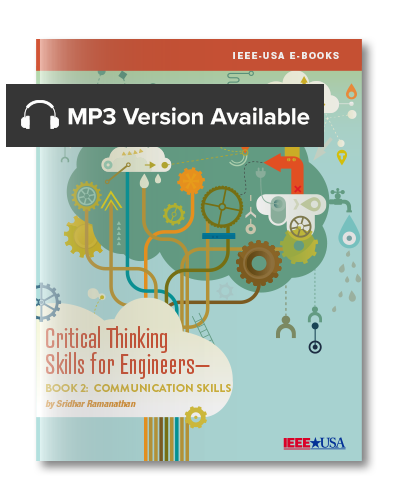
Author: Sridhar Ramanathan | Download FREE audiobook
build on the analytical skills in Book 1 of the Critical Thinking Skills for Engineers E-Book Series — this e-book (Book 2) moves into the context of a team, department, or larger organization — where communication skills will play a vital role in your career success as an engineer.
E-Book (PDF)
Member: FREE Non-Member: $4.99
Description
Continuing to build on the analytical skills in Book 1 of the Critical Thinking Skills for Engineers E-Book Series — this e-book (Book 2) moves into the context of a team, department, or larger organization — where communication skills will play a vital role in your career success as an engineer. Often, you will need to share your thinking and conclusions with your employers, or with a group of colleagues. You might also need to engage in critical thinking as a group—where both oral and written communications will be essential to group effectiveness in achieving a specific goal. This e-book focuses on the key elements of communication skills — to advance the critical thinking of a group-at-large.
Related products

Starting Your Start-Up – Book 2: Market Size and Strategy
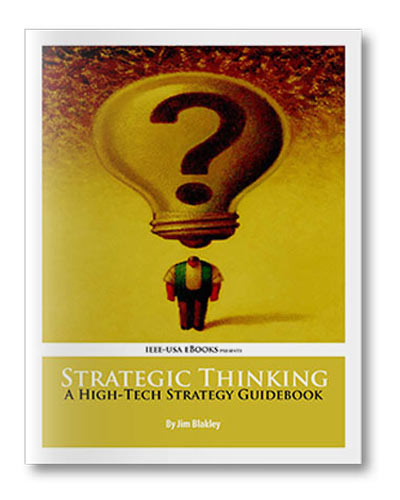
Strategic Thinking: A High-Tech Strategy Guidebook
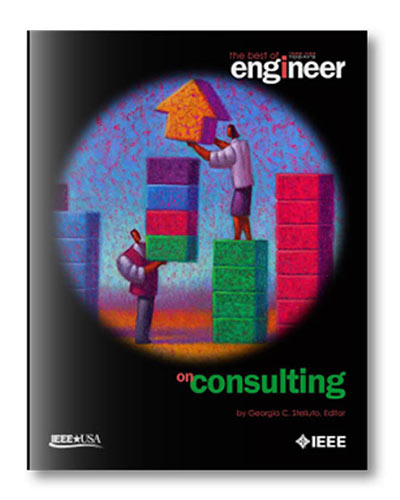
The Best of Today’s Engineer: On Consulting – Vol. 1

IEEE-USA is an organizational unit of IEEE, created in 1973 to support the career and the public policy interests of IEEE’s U.S. members. IEEE is the world’s largest technical professional organization dedicated to advancing technology for the benefit of humanity.
Next Conference

IEEE New Era World Leaders AI Summit
24 august - 25 august, next webinar.

IEEE-USA Washington Update
5 september @ 1:00 pm - 2:00 pm.
10 Best Books on Critical Thinking & Analytical Skills
In today’s world, where information is abundant and often conflicting, it’s essential to possess strong critical thinking and analytical skills. Critical thinking helps us make informed decisions, evaluate arguments and claims, and solve problems. Analytical skills, on the other hand, allow us to break down complex issues and data into more manageable parts, making it easier to understand and act upon them.
Why Critical Thinking and Analytical Skills are Essential
Critical thinking and analytical skills are essential because they enable us to navigate the ever-changing landscape of information, knowledge, and ideas. In a world where we are bombarded with information from multiple sources, these skills help us assess the reliability and validity of that information and make informed decisions.
Moreover, critical thinking and analytical skills are crucial for academic success. Students who develop these skills can analyze and evaluate complex texts, arguments, and ideas, and formulate their own opinions based on evidence. These skills also help students in their research projects, enabling them to differentiate between credible and unreliable sources, and critically evaluate the evidence presented in those sources.
The Importance of Critical Thinking in Daily Life
Every aspect of our life requires critical thinking, be it personal relationships, buying a product online, or evaluating political campaigns. Critical thinking helps us identify and evaluate assumptions, biases, and arguments and make decisions based on evidence.
For instance, critical thinking can help us evaluate the claims made in advertisements and make informed decisions about the products we buy. It can also help us identify and challenge stereotypes and biases in our personal relationships, leading to more respectful and inclusive interactions.
How Analytical Skills Enhance Problem-Solving Abilities
Problem-solving is an essential skill in the workplace and personal life. Analytical skills help us break down complex problems into smaller parts, identify the root causes, and develop effective solutions. Analytical thinkers can predict possible outcomes and assess the risks involved in decision-making.
Furthermore, analytical skills can help us in our everyday life. For example, when faced with a household problem such as a leaky faucet, analytical skills can help us diagnose the problem, identify the necessary tools and materials, and develop a plan to fix the issue.
In conclusion, critical thinking and analytical skills are essential for success in both personal and professional life. These skills enable us to make informed decisions, evaluate information, and solve complex problems. Therefore, it is important to cultivate these skills through education and practice.
The Top 10 Books on Critical Thinking
Critical thinking is an essential skill that helps us navigate the complexities of the world around us. It enables us to analyze information, evaluate arguments, and make informed decisions. If you’re looking to improve your critical thinking skills, here are ten books that can help you on your journey.
“Thinking, Fast and Slow” by Daniel Kahneman
This book is a fascinating exploration of how our brain processes information and makes decisions. Drawing on insights from neuroscience, psychology, and economics, Kahneman shows how we can overcome cognitive biases and think more critically. He also offers practical tips for improving our decision-making skills.
You can find this book here .
“The Art of Thinking Clearly” by Rolf Dobelli
In this book, Dobelli provides readers with 99 clear-thinking errors, biases, and fallacies that they should avoid. He uses real-life examples to make his points more relatable and offers practical advice for improving our critical thinking skills.
“The 5 Elements of Effective Thinking” by Edward B. Burger and Michael Starbird
This book draws on insights from neuroscience, education, and psychology to reveal the five essential elements of critical thinking. Burger and Starbird provide a framework for thinking about challenging problems and coming up with innovative solutions. They also offer practical tips for improving our problem-solving skills.
“Critical Thinking: A Concise Guide” by Tracy Bowell and Gary Kemp
If you’re new to critical thinking, this book is an excellent place to start. Bowell and Kemp provide readers with an introduction to critical thinking, including a breakdown of the key concepts, tools, and techniques. They also cover ethics, reasoning, and argument evaluation.
“The Power of Critical Thinking” by Lewis Vaughn
In this book, Vaughn explores how critical thinking can improve our daily lives. He provides tips and tools for analyzing and evaluating arguments, and includes real-life examples and exercises to help readers develop their critical thinking skills.
“Think Smarter: Critical Thinking to Improve Problem-Solving and Decision-Making Skills” by Michael Kallet
Kallet offers readers a step-by-step approach to critical thinking, including how to identify biases, assumptions, and problems. He also provides tools and techniques that can help in making better decisions. This book is a must-read for anyone looking to improve their problem-solving skills.
“The Demon-Haunted World: Science as a Candle in the Dark” by Carl Sagan
Sagan’s book is a powerful exploration of the importance of scientific thinking and skepticism in a world where misinformation and superstition often dominate. He provides readers with a foundation in scientific thinking that can help them evaluate claims and evidence more effectively.
“Nonsense: The Power of Not Knowing” by Jamie Holmes
In this book, Holmes explores how embracing uncertainty and ambiguity can improve critical thinking skills. He includes real-life examples and explores how different approaches to problem-solving can lead to better outcomes. This book is a great read for anyone looking to expand their thinking beyond the confines of certainty.
“The Logic of Scientific Discovery” by Karl Popper
This book is a classic in the philosophy of science and explores how scientific theories are developed and tested. Popper provides readers with a framework for evaluating claims and evidence and can help them understand the scientific process more fully. This book is a must-read for anyone interested in the scientific method.
“The Structure of Scientific Revolutions” by Thomas S. Kuhn
Kuhn’s book explores how scientific paradigms shift over time and how new ideas and technologies can challenge and replace old ones. He provides readers with a deeper understanding of how scientific ideas are developed and can help them evaluate the validity and reliability of scientific claims and evidence. This book is a fascinating read for anyone interested in the history of science.
Tips for Developing Your Critical Thinking Skills
Developing critical thinking skills is essential for navigating the complexities of modern life with confidence and clarity. In addition to reading books on the subject, there are several ways to develop your critical thinking skills. Here are a few tips:
Practice Active Listening
Active listening is a crucial component of critical thinking. When you’re communicating with others, actively listen to what they’re saying, and ask questions to clarify their points. This will help you understand their perspective and challenge your own assumptions. By doing so, you can broaden your perspective and gain new insights that you may not have considered before.
For example, if you’re having a conversation with someone who has a different political view than you, instead of immediately dismissing their opinion, ask them why they believe what they do. By doing so, you can gain a better understanding of their perspective and challenge your own assumptions.
Ask Thought-Provoking Questions
Asking thought-provoking questions is another way to develop your critical thinking skills. Instead of accepting surface-level explanations, dig deeper by asking questions that challenge assumptions and break down complex problems. Questions like “why?” and “how?” can help you identify underlying issues and gain a deeper understanding of a problem.
For example, if you’re trying to solve a problem at work, instead of accepting the first solution that comes to mind, ask yourself why that solution is the best option. By doing so, you can identify potential flaws in your thinking and develop a more effective solution.
Reflect on Your Own Thinking Process
Self-reflection is a critical component of developing your critical thinking skills. Take time to reflect on your own thinking process and identify any biases or assumptions that may be influencing your decisions. By doing so, you can become more aware of your own thought patterns and develop more effective strategies for critical thinking.
For example, if you’re trying to make a decision about a job offer, take time to reflect on your own biases and assumptions about the job, the company, and the industry. By doing so, you can make a more informed decision that is based on facts rather than assumptions.
Reading books on critical thinking and analytical skills can also help us develop a more effective approach to problem-solving and decision-making. By honing these skills, we can navigate the complexities of modern life with confidence and clarity.
- Recent Posts
- The 11 Best Books About Cats You Should Read - January 16, 2024
- The 9 Best Books on Building Confidence - January 16, 2024
- Discover the 10 Best Books on the Brain - January 16, 2024
Related Posts:

Best Books on Critical Thinking
Dive into the realm of logic and reason with this collection – the most recommended books on critical thinking, curated based on frequent recommendations from leading book blogs and publications..

Academia.edu no longer supports Internet Explorer.
To browse Academia.edu and the wider internet faster and more securely, please take a few seconds to upgrade your browser .
Enter the email address you signed up with and we'll email you a reset link.
- We're Hiring!
- Help Center

Critical Thinking and Problem Solving Thinking Skills Thinking Skills Critical Thinking and Problem Solving Second edition
This lively coursebook encourages students to develop more sophisticated and mature thinking processes by learning specii c, transferable skills independent of subject content which assist conn dent engagement in argument and reasoning. As well as giving a thorough grounding in critical thinking and problem solving, the book discusses how to analyse and evaluate arguments, manipulate numerical and graphical information and develop a range of skills including data handling, logic and reasoning. The second edition of the book has been substantially updated with new and revised content throughout. The only endorsed coursebook offering complete coverage of the Cambridge AS and A Level Thinking Skills syllabus, this resource also contains extensive extra material to cover a wide range of related awards. Features include: • clearly focused and differentiated critical thinking and problem solving units that provide complete coverage of the Thinking Skills syllabus and beyond • a range of stimulating student activities with commentaries to develop analytical skills • summary of key concepts at the end of each chapter to review learning • end-of-chapter assignments to reinforce knowledge and skills, with answers at the back for self-assessment • a mapping grid to demonstrate the applicability of each unit to awards including Critical Thinking, BMAT and TSA. Thinking Skills is written by two experienced examiners, who have produced a lively and accessible text which all students of Thinking Skills will nd invaluable. Visit education.cambridge.org/cie for information on our full range of Cambridge International A Level titles including e-book versions and mobile apps.
Related Papers
Dr Jason J Braithwaite
Journal of Legal Studies Education
Mujibussalim H. Palindra
Charlene Tan
This chapter introduces key concepts in critical thinking using films and music videos. It focuses on the critical thinking skills needed for the identification, analysis and evaluation of arguments. Based on 12 key questions, readers are introduced to core features of an argument such as “premise”, “conclusion” and “assumption”. The main types of arguments and the criteria for evaluating these arguments are also discussed. Throughout the chapter, films such as A Beautiful Mind, Bowling for Columbine and CSI: Miami, and music videos of John Lennon’s “Imagine”, Britney Spears’ “Toxic”, Michael Jackson’s “Billie Jean” and others are used to illustrate the concepts.
Contemporary Buddhism
ligeia lugli
Educational Philosophy and Theory
Jennifer W Mulnix
As a philosophy professor, one of my central goals is to teach students to think critically. However, one difficulty with determining whether critical thinking can be taught, or even measured, is that there is widespread disagreement over what critical thinking actually is. Here, I reflect on several conceptions of critical thinking, subjecting them to critical scrutiny. I also distinguish critical thinking from other forms of mental processes with which it is often conflated. Next, I present my own conception of critical thinking, wherein it fundamentally consists in acquiring, developing, and exercising the ability to grasp inferential connections holding between statements. Finally, given this account of critical thinking, and given recent studies in cognitive science, I suggest the most effective means for teaching students to think critically.
Informal Logic
Trudy Govier
Loading Preview
Sorry, preview is currently unavailable. You can download the paper by clicking the button above.
- We're Hiring!
- Help Center
- Find new research papers in:
- Health Sciences
- Earth Sciences
- Cognitive Science
- Mathematics
- Computer Science
- Academia ©2024
Best Books Hub
Reviews of The Best Books on Every Subject
20 Best Books on Critical Thinking (2022 Review)
September 16, 2020 by James Wilson
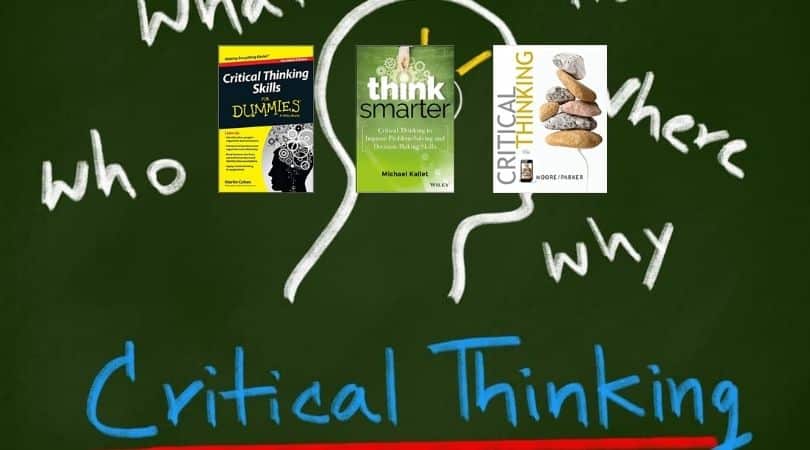
DISCLOSURE: This post may contain affiliate links, meaning when you click the links and make a purchase, I receive a commission. As an Amazon Associate I earn from qualifying purchases.
Critical thinking is a skill/mindset that enables a person to think logically. Critical thinking is a vital necessity for everyone these days who want to perform exceptionally. No matter what field of life you are in, let it be a student, a teacher, an athlete or a corporate employee. There are high chances that you will need to enable critical thinking to find a noteworthy solution to your problems and be able to move forward effectively.
To enable critical thinking, there are certain things involved. These include evaluating evidence, weighing the chances, analysing assumptions and more. Once you start your journey towards critical thinking, you start to take the next steps automatically. It is a journey that takes you from assumptions to the realities that are possible.
What are the Best Critical Thinking Books to read?

With effective critical thinking skills, it is impossible for you to be fooled by anyone. You can read one’s intentions right away. You can even see what other people cannot, based on evidence and argument.
If you are looking to grow respective critical thinking skills, and want to learn it quick. We have compiled a list of books that you can read the review for. This will enable you to choose the right book on critical thinking for your learning journey.
Best Books on Critical Thinking: Our Top 20 Picks
Here are some of the best critical thinking books that you can consider to expand your knowledge on the subject:
1. Critical Thinking Skills for Dummies

Of Course, we all are already aware of the “For Dummies” series. For those who are not, this series presents an absolute and definitive guide for the beginners. With the help of this series, everyone can effectively learn the skills from the beginner level to advance. If you have little to zero knowledge about critical thinking and want to learn, this is the book for you.
The book has been written by Martin Cohen. It serves the purpose by enabling its readers to get access to the most comprehensible and easy-to-read narrative on critical thinking. The book provides you with access to several tools that you can activate to develop reflective thinking. There is also deep insight from the beginners’ level on how you can brainstorm to generate insights.
- Authors : Martin Cohen (Author)
- Publisher : For Dummies; 1st Edition (May 4, 2015)
- Pages : 376 pages
2. Think Smarter: Critical thinking to improve problem-solving and decision-making skills
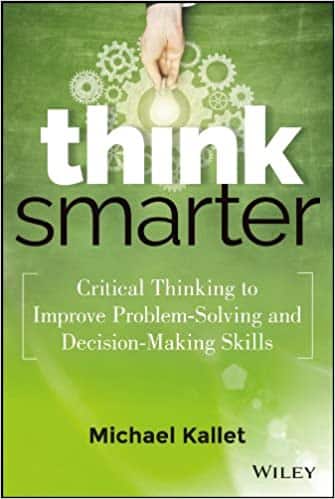
Critical thinking is a necessary skill for all that are studying, teaching, or working in any part of life. It enables you to look at the flaws in a system, a story, a program, a project or virtually anything so you can effectively improve it.
This book is all about using critical thinking to improve problem-solving and decision-making skills. Written by Michael Kallet, the book presents valuable arguments that you can use to weigh your options, find the flaws and improve your critical thinking skills. This book goes beyond the concepts and is about the examples of real-world scenarios that will not only serve as a clear piece of understanding for you but also help you with the exercise and practice of such skills. The book has over 25 tools for critical thinking with real-world examples.
- Authors : Michael Kallet (Author)
- Publisher : Wiley; 1st Edition (April 7, 2014)
- Pages : 240 pages
3. Critical Thinking (10th Edition)

There are levels of Critical thinking classified with the understanding and utilization level of the students. The course enables students to think logically and critically not only in the class but in the real-world to make effective decisions.
It will not be wrong to call this book the most taught textbook on critical thinking subjects. The book is written by Brooke Noel Moore and Richard Parker. It presents the students with a buffet of examples and exercises that they can perform within or outside the class to enable their critical thinking skills and do well in their life. The book presents a highly understandable version of critical thinking in Moore’s famous, engaging narrative.
- Authors : Brooke Noel Moore (Author), Richard Parker (Author)
- Publisher : McGraw-Hill; 10th Edition (January 1, 2012)
- Pages : 576 pages
4. Critical Thinking: Tools for taking charge of your learning and your life (3rd Edition)
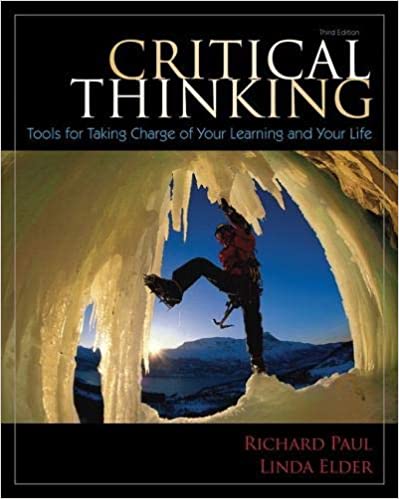
Critical thinking has become highly popular in the last couple of decades. It enables you with an approach of integration and making decisions based on viable arguments and evidence instead of hallow words. The sixth sense is a thing, but weighing your arguments and the right evidence laying in front of you is what critical thinking enables you to do.
Written by two experts of the field Richard Paul, and Linda Elder, this book presents its readers with a huge list of interactive tools that they can learn to utilize in their learning journey towards critical thinking. This book is focused on a comprehensive and practical approach to critical thinking that is to be used in everyday life. With this book, you can get your hands on some new diagrams that will enhance your decision-making skills.
- Authors : Richard Paul (Author), Linda Elder (Author)
- Publisher : Pearson; 3rd Edition (November 20, 2019)
- Pages : 528 pages
5. The power of Critical Thinking: Effective Reasoning about Ordinary and Extraordinary claims
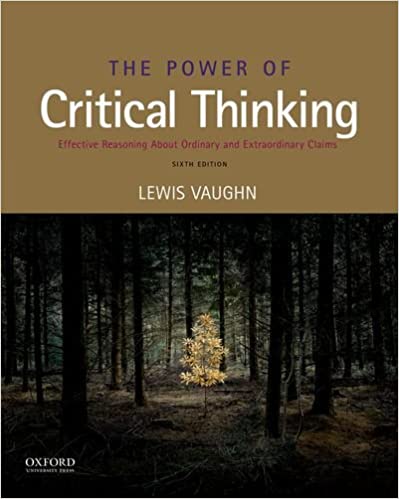
Critical thinking is a power that takes you from assuming to believing. It enables you to understand the truth laying behind the valid evidences that someone is trying to hide it from you. It is a skill to believe in the true version of events instead of hallow words.
Written by Lewis Vaughn, this book is the right read for you if you are looking to enable and use critical thinking in your daily routine. The book enables you access to a wide range of tools you need to apply for critical thinking in daily life. It provides a perspective understandable and applicable by students, teachers, corporate workers, and normal people alike. Including scientific reasoning, evidence, authority, and visual reasoning this book can enable you to get the skills of critical thinking in a commendable manner.
- Authors : Lewis Vaughn (Author)
- Publisher : Oxford University Press; 6th Edition (September 20, 2018)
- Pages : 600 pages
6. Critical Thinking, Reading and Writing: A Brief Guide to Argument (9th Edition)
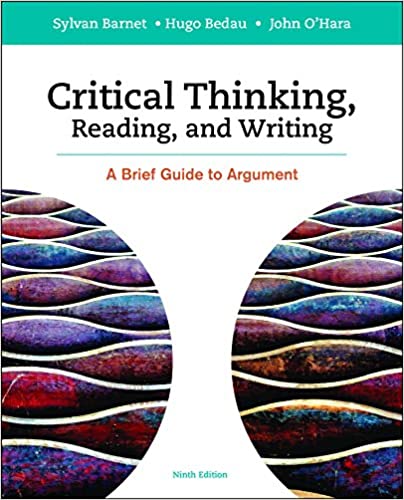
If you are a reader, student or an individual with a job requirement of reading and getting the right information. This book is the right guide for you. This book is a comprehensive, compact guide for all those who want to learn the right skillset to weigh arguments based on validity and authority.
The book presents you with a number of real-life examples that will enable you to understand the fundamentals of skimming through the information and improve your analysis to reach the right conclusion. Written by Sylvan Barnet, Hugo Bedau, and John O’Hara this book has all the information and guidance to enable critical thinking and create valid arguments based on facts and figures.
- Authors : Sylvan Barnet (Author), Hugo Bedau (Author), John O’Hara (Author)
- Publisher : Bedford/St. Martin’s; Ninth Edition (October 4, 2016)
7. Critical Thinking (11th Edition)
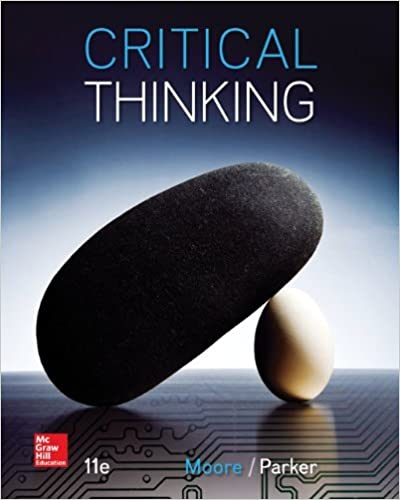
Critical thinking is being taught as a course in most schools. It enables the students to make the right decisions in life effectively and to weigh the chances for their success. Critical thinking is a necessary tool for all who want to survive in this highly competitive world and outperform their selves every day.
It will not be wrong to call this book a Textbook. Written by Brooke Noel Moore, and Richard Parker this book contains a unique and interactive approach towards learning the skills required to enable critical thinking. There are real-world applications that enable the students and instructors alike to understand the concepts better. The book is a great help for not only scoring grades in the course but also being able to use the concepts and learnings effectively in daily routine.
- Publisher : McGraw-Hill Education; 11th Edition (January 15, 2014)
- Pages : 512 pages
8. Models for Critical Thinking: A fundamental guide to effective decision making, deep analysis, Intelligent reasoning, and independent thinking
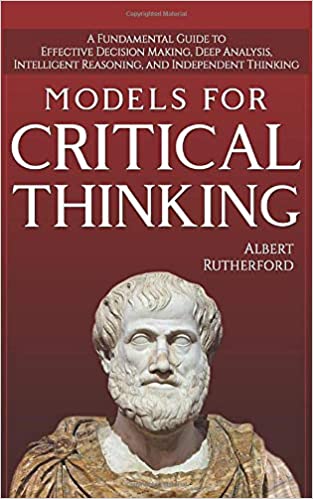
Critical thinking has benefits far more reasonable and useful beyond the academic career. While there are no doubts about the importance of critical thinking for educational purposes. There are also a number of other applications that you can use critical thinking to analyse and understand the process of certain things going around.
Written by Albert Rutherford, this book is a marvel of critical thinking. With this book, you can get your hands on some advance concepts and techniques used to enable critical thinking. And the best part is, there are also numerous applications including that will enable you to enhance your critical thinking skills. The book contains elaborative insight on how you can apply logic to analyse and everyday events around you and use that to save yourself from getting tricked or manipulated.
- Authors : Albert Rutherford (Author)
- Publisher : Independently published (October 17, 2018)
- Pages : 278 pages
9. LOGITICA: Improve your critical thinking and problem-solving skills: the brain behind the brain
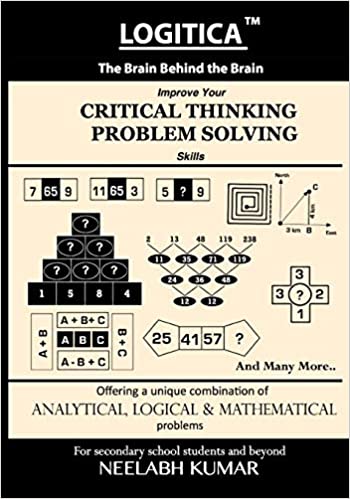
Problem-solving skills rely greatly on critical thinking. To understand an error in your work and to effectively eliminate that requires a deeper sense of understanding towards the comprehension of the reasons that may have caused the error and how you can improve.
This book is based on logistical facts and figures rather than assumptions, that could have been true. Logics presents you with a more accurate opportunity and approach towards improving our problem-solving skills. Written by Neelabh Kumar, this book is a right guide for all those who want to understand an in-depth perspective of what may have caused an error and how you can eliminate the possibility of recurrence through enhances critical thinking skills.
- Authors : Neelabh Kumar (Author)
- Publisher : Independently published (January 8, 2019)
- Pages : 329 pages
10. A workbook for arguments, Second Edition: A complete course in critical thinking
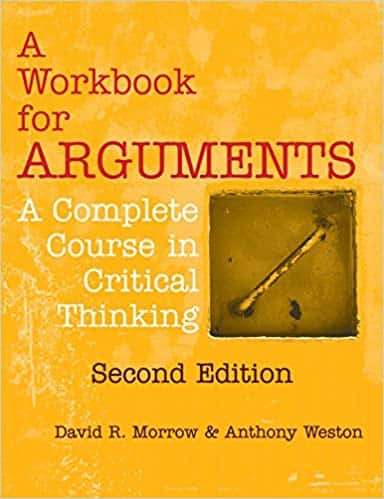
This second edition of a highly popular guide on critical thinking contains all major improvements that back the fundamentals of the first edition. However, advancement and revelations are continued and this book is the right example of moving forward in your journey of learning critical thinking efficiently.
The book is written by David R. Morrow and Anthony Weston. In this book, they present an understandable and easy to imply narrative towards critical thinking. The book contains elaborative information on all the exercises of critical thinking. Also, it has improved and enhanced version of scientific reasoning that was discussed in earlier edition. This is a perfect workbook for all the students and those who are looking to improve their critical thinking skills.
- Authors : David R. Morrow (Author), Anthony Weston (Author)
- Publisher : Hackett Publishing Company, Inc.; Second Edition (November 1, 2015)
11. From Critical Thinking to Argument: A Portable Guide (5th Edition)
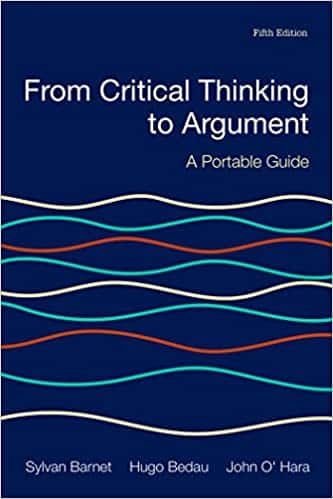
Critical Thinking is a valuable skill for all, especially the writers. While other people have to self-analyse and use the information for their own improvements and apply them their selves. Writers are required to craft the arguments based on the information and their critical thinking skills.
This book is written by Sylvan Barnet, Hugo Bedau, and John O’Hara. It is a handbook that is compact and has a precise narrative to not only enhance critical thinking skills but also to improve the knowledge. The book contains practical exercises on how one can effectively craft the arguments based on facts, figures, and assumptions that might come true.
- Publisher : Bedford/St. Martin’s; Fifth Edition (December 22, 2016)
- Pages : 432 pages
12. Critical Thinking: The effective Beginner’s guide to master logical facilities using a scientific approach and improve your rational thinking skills with problem-solving tools to make better decisions
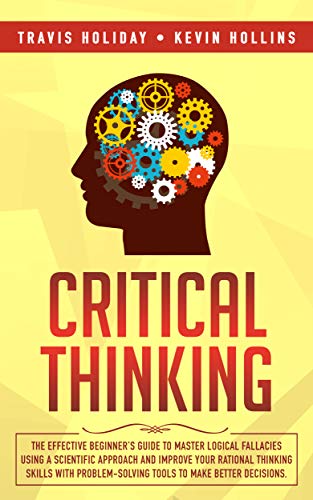
Thinking deep and analytically requires you to work on your thinking process and analyse the information effectively. These are some skills that require you to work on yourself and the way you look at things. It includes changing your narrative towards the things that might be causing hindrance in your thinking process and clouding your judgment.
The book is written & published by Travis Holiday, and Kevin Hollins. This is the right guide for all the beginners to start thinking rationally and based on the facts that are affecting things around you. There are indicators that allow you to see the reality hidden behind things and words with absolute meaning. However, there are deeper practices along the way and you must understand those to start thinking effectively the right possible way. This book is the right guide that will take you from beginner to master-level critical thinking approach through its easy to understand and imply a narrative.
- Authors : Travis Holiday (Author), Kevin Hollins (Author)
- Publisher : Independently published (September 18, 2019)
- Pages : 210 pages
13. Critical Thinking (12th Edition)
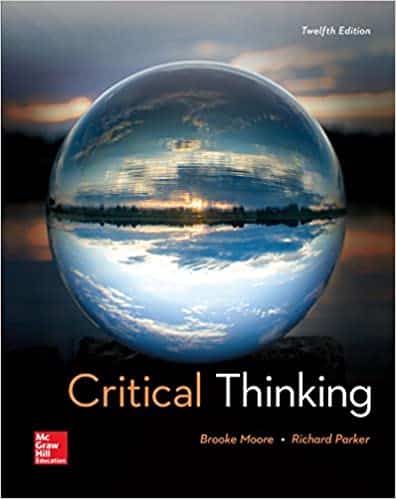
Researches are being conducted daily on critical thinking. With each passing day, there are new and more effective concepts that are being discovered and proven right. These concepts are not a denial to older ones but strengthen their validity. If you are looking to get your hands on some of the latest concepts of Critical thinking, this is the right book for you.
Written by Brooke Noel Moore and Richard Parker, this book presents you with the most up-to-date concepts of critical thinking. It has an improved narrative and hundreds of latest examples based on real-world scenarios that will enable you to think critically and improve your decision-making skills in every part of your life.
- Publisher : McGraw-Hill Higher Education; 12th Edition (October 25, 2016)
14. The basics of Critical Thinking

Young minds are more interesting and they are more curious. Curiosity is considered the first step toward critical thinking. It is believed that habits made in early age stays with you for life. Critical thinking is more of a habit, a lifestyle than a skill set that you can earn over time. Hence, this book presents a version of basic tools that can enable younger minds to get hold of the basics of critical thinking.
The book follows simple English with a narrative that is easier to understand for children. To increase interest, this book contains a colourful and image-based description of things. The book is written by Michael Baker. While it is intended for younger people, that does not mean adults cannot read it. For all those who want to learn the fundamentals of critical thinking and to enable their selves to analyse things effectively, this book is a worthy read.
- Authors : Michael Baker (Author), Children’s Books – Educational (Introduction)
- Publisher : The Critical Thinking Co. (January 1, 2015)
- Pages : 152 pages
15. Tools of Critical Thinking: Meta thoughts of psychology, second edition.
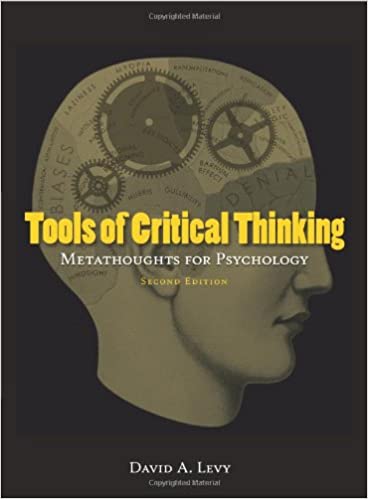
While there are other books that focus on basics and how you can start analysing things and events to think critically. This book is focused more on in-depth analysis and understanding of psychology involved behind decision making and critical thinking approach.
Written by David A. Levy, this book presents a highly understandable narrative and approach towards thinking critically and to understand how human psychology works towards it. If you are having problems in thinking critically due to the emotions attached and are unable to get ahead of these. This book is the perfect guide for you.
- Authors : David A. Levy (Author)
- Publisher : Waveland Pr Inc; 2nd Edition (September 1, 2009)
- Pages : 298 pages
16. Your Deceptive Mind: A Scientific guide to critical thinking skills

Our minds can often deceive us to think differently, while the truth is looking right in your eyes. Being said that, human judgment and decision making can often be clouded by certain feelings that are attached to it. There is no denial to it that sometimes we are unable to look at the reality because of our emotions and feelings.
This book is the right guide for all those who think that they are lacking in any field of life due to their emotions and being unable to think critically on the subject. The book presents you with a blunt and harsh narrative to stop relying on emotions and scientifically understand the factors that are stopping you from thinking critically and efficiently. It is written by Steven Novella and published by The Great Courses. The book also includes a critical toolbox that you can use to access the quality of information and skillset required to think critically.
- Authors : Professor Steven Novella (Author), Yale School of Medicine (Foreword)
- Publisher : The Great Courses (January 1, 2012)
17. Master Critical Thinking: Think Intelligently, Improve Problem-Solving Skills, make better Decisions, and Upgrade your life.
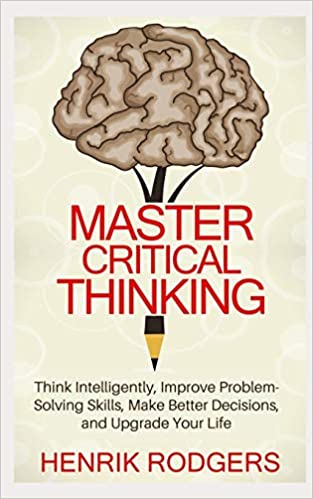
To master critical thinking, one must have several goals. The goals can be thinking intelligently and enable enhanced thinking, improving your problem-solving skills or simply making better decisions in everyday life.
Whatever your goals may be, critical thinking is the right approach towards upgrading your life with the help of improving each decision and backing it based on solid arguments instead of vague assumptions and emotions attached to it that can be deceiving at times. If you often struggle with the urge to make the right decision and want to get over with the gut feelings you have. This book will guide you to start thinking critically instead of simply relying on emotions and assumptions.
- Authors : Henrik Rodgers (Author)
- Publisher : Independently published (July 9, 2019)
- Pages : 116 pages
18. Critical Thinking: The Beginners User manual to Improve your communication and self-confidence skills Every day. The Tools and the concepts for problem-solving and decision making.
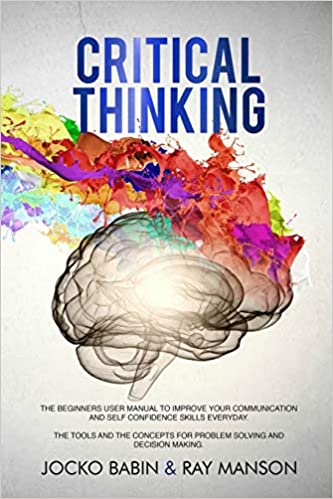
To learn from your own failures is the right way to understand and not make those mistakes again. It is the best practice to improve your own-self. However, to improve and to correct your own mistakes, the right approach is to realise them. While there are people, who can turn a blind eye towards their own mistakes. This book is the right guide that teaches you how not to. The book contains great insight into self-realization and how you can use it to improve your own thinking skills.
The book is written by Jacko Babin and Ray Manson. It contains elaborative insight on how you can effectively stop second-guessing yourself and have a confident approach towards improving the mistakes. Once you have realized your own mistakes, the rest of the journey becomes easier for you. The book also contains numerous real-life examples that will help you understand these concepts in a much better way.
- Authors : Jocko Babin (Author), Ray Manson (Author)
- Publisher : Independently published (March 9, 2019)
- Pages : 147 pages
19. A concise guide to critical thinking (1st Edition)

Lewis Vaughn is considered an expert on the subject of critical thinking. He has written several books covering the topic. His books contain an in-depth analysis of how you can enable critical thinking in your daily routine and what might be stopping you from doing so.
This book, however, can be deemed as a complete summary of concepts being advocated by him. Along with the guidance on covering the obstacles that are stopping you and enabling your mind to think critically. This book contains a highly understandable and easy to follow the narrative that will be great for all the beginners to understand and imply critical thinking from scratch to master level.
- Publisher : Oxford University Press; Annotated – Illustrated Edition (October 1, 2017)
- Pages : 352 pages
20. The miniature guide to critical thinking concepts and tools (Thinker’s guide library)
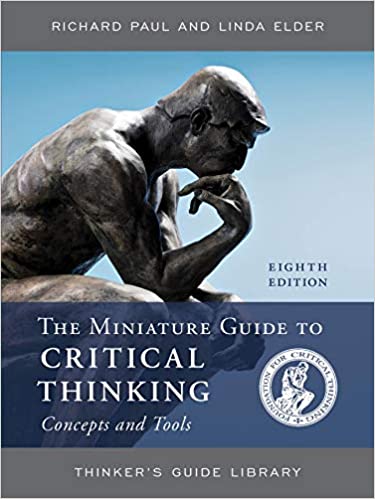
If you are looking to master critical thinking and do not have time to read extensive concepts and get yourself indulged with the psychic or scientific approach. This is the book for you. This book presents a concise and to-the-point approach to critical thinking concepts and tools.
Written by Richard Paul and Linda Elder, the book does not only contain all the information required to understand the concepts on critical thinking but also how you can imply those in your daily life to enhance your decision making and critical thinking skills effectively. The book presents a short and easy to follow approach towards the subject.
- Publisher : The Foundation for Critical Thinking; Eighth Edition (September 20, 2019)
- Pages : 48 pages
Choosing the Best Critical Thinking Books
Critical thinking is not just a skill-set. It is a way of life that enables you to make the right decisions in every part of life. It also enables you to understand the things, events and the factors involved behind them efficiently. With the help of critical thinking, you can analyse the events and decisions unbiased by any sort of feelings or attachments.
We have gone through these books and compiled a list of critical reviews on these books. If you are looking to start thinking critically and are unsure of where to start. This guide will definitely help you to choose the right book to aid your learning journey.

Subscribe To Email List
FREE Great Book Recommendations
Don't Miss Out On Books You Must Read
We won't send you spam. Unsubscribe at any time

Introduction to Logic and Critical Thinking
(10 reviews)
Matthew Van Cleave, Lansing Community College
Copyright Year: 2016
Publisher: Matthew J. Van Cleave
Language: English
Formats Available
Conditions of use.
Learn more about reviews.
Reviewed by "yusef" Alexander Hayes, Professor, North Shore Community College on 6/9/21
Formal and informal reasoning, argument structure, and fallacies are covered comprehensively, meeting the author's goal of both depth and succinctness. read more
Comprehensiveness rating: 5 see less
Formal and informal reasoning, argument structure, and fallacies are covered comprehensively, meeting the author's goal of both depth and succinctness.
Content Accuracy rating: 5
The book is accurate.
Relevance/Longevity rating: 5
While many modern examples are used, and they are helpful, they are not necessarily needed. The usefulness of logical principles and skills have proved themselves, and this text presents them clearly with many examples.
Clarity rating: 5
It is obvious that the author cares about their subject, audience, and students. The text is comprehensible and interesting.
Consistency rating: 5
The format is easy to understand and is consistent in framing.
Modularity rating: 5
This text would be easy to adapt.
Organization/Structure/Flow rating: 5
The organization is excellent, my one suggestion would be a concluding chapter.
Interface rating: 5
I accessed the PDF version and it would be easy to work with.
Grammatical Errors rating: 5
The writing is excellent.
Cultural Relevance rating: 5
This is not an offensive text.
Reviewed by Susan Rottmann, Part-time Lecturer, University of Southern Maine on 3/2/21
I reviewed this book for a course titled "Creative and Critical Inquiry into Modern Life." It won't meet all my needs for that course, but I haven't yet found a book that would. I wanted to review this one because it states in the preface that it... read more
Comprehensiveness rating: 4 see less
I reviewed this book for a course titled "Creative and Critical Inquiry into Modern Life." It won't meet all my needs for that course, but I haven't yet found a book that would. I wanted to review this one because it states in the preface that it fits better for a general critical thinking course than for a true logic course. I'm not sure that I'd agree. I have been using Browne and Keeley's "Asking the Right Questions: A Guide to Critical Thinking," and I think that book is a better introduction to critical thinking for non-philosophy majors. However, the latter is not open source so I will figure out how to get by without it in the future. Overall, the book seems comprehensive if the subject is logic. The index is on the short-side, but fine. However, one issue for me is that there are no page numbers on the table of contents, which is pretty annoying if you want to locate particular sections.
Content Accuracy rating: 4
I didn't find any errors. In general the book uses great examples. However, they are very much based in the American context, not for an international student audience. Some effort to broaden the chosen examples would make the book more widely applicable.
Relevance/Longevity rating: 4
I think the book will remain relevant because of the nature of the material that it addresses, however there will be a need to modify the examples in future editions and as the social and political context changes.
Clarity rating: 3
The text is lucid, but I think it would be difficult for introductory-level students who are not philosophy majors. For example, in Browne and Keeley's "Asking the Right Questions: A Guide to Critical Thinking," the sub-headings are very accessible, such as "Experts cannot rescue us, despite what they say" or "wishful thinking: perhaps the biggest single speed bump on the road to critical thinking." By contrast, Van Cleave's "Introduction to Logic and Critical Thinking" has more subheadings like this: "Using your own paraphrases of premises and conclusions to reconstruct arguments in standard form" or "Propositional logic and the four basic truth functional connectives." If students are prepared very well for the subject, it would work fine, but for students who are newly being introduced to critical thinking, it is rather technical.
It seems to be very consistent in terms of its terminology and framework.
Modularity rating: 4
The book is divided into 4 chapters, each having many sub-chapters. In that sense, it is readily divisible and modular. However, as noted above, there are no page numbers on the table of contents, which would make assigning certain parts rather frustrating. Also, I'm not sure why the book is only four chapter and has so many subheadings (for instance 17 in Chapter 2) and a length of 242 pages. Wouldn't it make more sense to break up the book into shorter chapters? I think this would make it easier to read and to assign in specific blocks to students.
Organization/Structure/Flow rating: 4
The organization of the book is fine overall, although I think adding page numbers to the table of contents and breaking it up into more separate chapters would help it to be more easily navigable.
Interface rating: 4
The book is very simply presented. In my opinion it is actually too simple. There are few boxes or diagrams that highlight and explain important points.
The text seems fine grammatically. I didn't notice any errors.
The book is written with an American audience in mind, but I did not notice culturally insensitive or offensive parts.
Overall, this book is not for my course, but I think it could work well in a philosophy course.
Reviewed by Daniel Lee, Assistant Professor of Economics and Leadership, Sweet Briar College on 11/11/19
This textbook is not particularly comprehensive (4 chapters long), but I view that as a benefit. In fact, I recommend it for use outside of traditional logic classes, but rather interdisciplinary classes that evaluate argument read more
Comprehensiveness rating: 3 see less
This textbook is not particularly comprehensive (4 chapters long), but I view that as a benefit. In fact, I recommend it for use outside of traditional logic classes, but rather interdisciplinary classes that evaluate argument
To the best of my ability, I regard this content as accurate, error-free, and unbiased
The book is broadly relevant and up-to-date, with a few stray temporal references (sydney olympics, particular presidencies). I don't view these time-dated examples as problematic as the logical underpinnings are still there and easily assessed
Clarity rating: 4
My only pushback on clarity is I didn't find the distinction between argument and explanation particularly helpful/useful/easy to follow. However, this experience may have been unique to my class.
To the best of my ability, I regard this content as internally consistent
I found this text quite modular, and was easily able to integrate other texts into my lessons and disregard certain chapters or sub-sections
The book had a logical and consistent structure, but to the extent that there are only 4 chapters, there isn't much scope for alternative approaches here
No problems with the book's interface
The text is grammatically sound
Cultural Relevance rating: 4
Perhaps the text could have been more universal in its approach. While I didn't find the book insensitive per-se, logic can be tricky here because the point is to evaluate meaningful (non-trivial) arguments, but any argument with that sense of gravity can also be traumatic to students (abortion, death penalty, etc)
No additional comments
Reviewed by Lisa N. Thomas-Smith, Graduate Part-time Instructor, CU Boulder on 7/1/19
The text covers all the relevant technical aspects of introductory logic and critical thinking, and covers them well. A separate glossary would be quite helpful to students. However, the terms are clearly and thoroughly explained within the text,... read more
The text covers all the relevant technical aspects of introductory logic and critical thinking, and covers them well. A separate glossary would be quite helpful to students. However, the terms are clearly and thoroughly explained within the text, and the index is very thorough.
The content is excellent. The text is thorough and accurate with no errors that I could discern. The terminology and exercises cover the material nicely and without bias.
The text should easily stand the test of time. The exercises are excellent and would be very helpful for students to internalize correct critical thinking practices. Because of the logical arrangement of the text and the many sub-sections, additional material should be very easy to add.
The text is extremely clearly and simply written. I anticipate that a diligent student could learn all of the material in the text with little additional instruction. The examples are relevant and easy to follow.
The text did not confuse terms or use inconsistent terminology, which is very important in a logic text. The discipline often uses multiple terms for the same concept, but this text avoids that trap nicely.
The text is fairly easily divisible. Since there are only four chapters, those chapters include large blocks of information. However, the chapters themselves are very well delineated and could be easily broken up so that parts could be left out or covered in a different order from the text.
The flow of the text is excellent. All of the information is handled solidly in an order that allows the student to build on the information previously covered.
The PDF Table of Contents does not include links or page numbers which would be very helpful for navigation. Other than that, the text was very easy to navigate. All the images, charts, and graphs were very clear
I found no grammatical errors in the text.
Cultural Relevance rating: 3
The text including examples and exercises did not seem to be offensive or insensitive in any specific way. However, the examples included references to black and white people, but few others. Also, the text is very American specific with many examples from and for an American audience. More diversity, especially in the examples, would be appropriate and appreciated.
Reviewed by Leslie Aarons, Associate Professor of Philosophy, CUNY LaGuardia Community College on 5/16/19
This is an excellent introductory (first-year) Logic and Critical Thinking textbook. The book covers the important elementary information, clearly discussing such things as the purpose and basic structure of an argument; the difference between an... read more
This is an excellent introductory (first-year) Logic and Critical Thinking textbook. The book covers the important elementary information, clearly discussing such things as the purpose and basic structure of an argument; the difference between an argument and an explanation; validity; soundness; and the distinctions between an inductive and a deductive argument in accessible terms in the first chapter. It also does a good job introducing and discussing informal fallacies (Chapter 4). The incorporation of opportunities to evaluate real-world arguments is also very effective. Chapter 2 also covers a number of formal methods of evaluating arguments, such as Venn Diagrams and Propositional logic and the four basic truth functional connectives, but to my mind, it is much more thorough in its treatment of Informal Logic and Critical Thinking skills, than it is of formal logic. I also appreciated that Van Cleave’s book includes exercises with answers and an index, but there is no glossary; which I personally do not find detracts from the book's comprehensiveness.
Overall, Van Cleave's book is error-free and unbiased. The language used is accessible and engaging. There were no glaring inaccuracies that I was able to detect.
Van Cleave's Textbook uses relevant, contemporary content that will stand the test of time, at least for the next few years. Although some examples use certain subjects like former President Obama, it does so in a useful manner that inspires the use of critical thinking skills. There are an abundance of examples that inspire students to look at issues from many different political viewpoints, challenging students to practice evaluating arguments, and identifying fallacies. Many of these exercises encourage students to critique issues, and recognize their own inherent reader-biases and challenge their own beliefs--hallmarks of critical thinking.
As mentioned previously, the author has an accessible style that makes the content relatively easy to read and engaging. He also does a suitable job explaining jargon/technical language that is introduced in the textbook.
Van Cleave uses terminology consistently and the chapters flow well. The textbook orients the reader by offering effective introductions to new material, step-by-step explanations of the material, as well as offering clear summaries of each lesson.
This textbook's modularity is really quite good. Its language and structure are not overly convoluted or too-lengthy, making it convenient for individual instructors to adapt the materials to suit their methodological preferences.
The topics in the textbook are presented in a logical and clear fashion. The structure of the chapters are such that it is not necessary to have to follow the chapters in their sequential order, and coverage of material can be adapted to individual instructor's preferences.
The textbook is free of any problematic interface issues. Topics, sections and specific content are accessible and easy to navigate. Overall it is user-friendly.
I did not find any significant grammatical issues with the textbook.
The textbook is not culturally insensitive, making use of a diversity of inclusive examples. Materials are especially effective for first-year critical thinking/logic students.
I intend to adopt Van Cleave's textbook for a Critical Thinking class I am teaching at the Community College level. I believe that it will help me facilitate student-learning, and will be a good resource to build additional classroom activities from the materials it provides.
Reviewed by Jennie Harrop, Chair, Department of Professional Studies, George Fox University on 3/27/18
While the book is admirably comprehensive, its extensive details within a few short chapters may feel overwhelming to students. The author tackles an impressive breadth of concepts in Chapter 1, 2, 3, and 4, which leads to 50-plus-page chapters... read more
While the book is admirably comprehensive, its extensive details within a few short chapters may feel overwhelming to students. The author tackles an impressive breadth of concepts in Chapter 1, 2, 3, and 4, which leads to 50-plus-page chapters that are dense with statistical analyses and critical vocabulary. These topics are likely better broached in manageable snippets rather than hefty single chapters.
The ideas addressed in Introduction to Logic and Critical Thinking are accurate but at times notably political. While politics are effectively used to exemplify key concepts, some students may be distracted by distinct political leanings.
The terms and definitions included are relevant, but the examples are specific to the current political, cultural, and social climates, which could make the materials seem dated in a few years without intentional and consistent updates.
While the reasoning is accurate, the author tends to complicate rather than simplify -- perhaps in an effort to cover a spectrum of related concepts. Beginning readers are likely to be overwhelmed and under-encouraged by his approach.
Consistency rating: 3
The four chapters are somewhat consistent in their play of definition, explanation, and example, but the structure of each chapter varies according to the concepts covered. In the third chapter, for example, key ideas are divided into sub-topics numbering from 3.1 to 3.10. In the fourth chapter, the sub-divisions are further divided into sub-sections numbered 4.1.1-4.1.5, 4.2.1-4.2.2, and 4.3.1 to 4.3.6. Readers who are working quickly to master new concepts may find themselves mired in similarly numbered subheadings, longing for a grounded concepts on which to hinge other key principles.
Modularity rating: 3
The book's four chapters make it mostly self-referential. The author would do well to beak this text down into additional subsections, easing readers' accessibility.
The content of the book flows logically and well, but the information needs to be better sub-divided within each larger chapter, easing the student experience.
The book's interface is effective, allowing readers to move from one section to the next with a single click. Additional sub-sections would ease this interplay even further.
Grammatical Errors rating: 4
Some minor errors throughout.
For the most part, the book is culturally neutral, avoiding direct cultural references in an effort to remain relevant.
Reviewed by Yoichi Ishida, Assistant Professor of Philosophy, Ohio University on 2/1/18
This textbook covers enough topics for a first-year course on logic and critical thinking. Chapter 1 covers the basics as in any standard textbook in this area. Chapter 2 covers propositional logic and categorical logic. In propositional logic,... read more
This textbook covers enough topics for a first-year course on logic and critical thinking. Chapter 1 covers the basics as in any standard textbook in this area. Chapter 2 covers propositional logic and categorical logic. In propositional logic, this textbook does not cover suppositional arguments, such as conditional proof and reductio ad absurdum. But other standard argument forms are covered. Chapter 3 covers inductive logic, and here this textbook introduces probability and its relationship with cognitive biases, which are rarely discussed in other textbooks. Chapter 4 introduces common informal fallacies. The answers to all the exercises are given at the end. However, the last set of exercises is in Chapter 3, Section 5. There are no exercises in the rest of the chapter. Chapter 4 has no exercises either. There is index, but no glossary.
The textbook is accurate.
The content of this textbook will not become obsolete soon.
The textbook is written clearly.
The textbook is internally consistent.
The textbook is fairly modular. For example, Chapter 3, together with a few sections from Chapter 1, can be used as a short introduction to inductive logic.
The textbook is well-organized.
There are no interface issues.
I did not find any grammatical errors.
This textbook is relevant to a first semester logic or critical thinking course.
Reviewed by Payal Doctor, Associate Professro, LaGuardia Community College on 2/1/18
This text is a beginner textbook for arguments and propositional logic. It covers the basics of identifying arguments, building arguments, and using basic logic to construct propositions and arguments. It is quite comprehensive for a beginner... read more
This text is a beginner textbook for arguments and propositional logic. It covers the basics of identifying arguments, building arguments, and using basic logic to construct propositions and arguments. It is quite comprehensive for a beginner book, but seems to be a good text for a course that needs a foundation for arguments. There are exercises on creating truth tables and proofs, so it could work as a logic primer in short sessions or with the addition of other course content.
The books is accurate in the information it presents. It does not contain errors and is unbiased. It covers the essential vocabulary clearly and givens ample examples and exercises to ensure the student understands the concepts
The content of the book is up to date and can be easily updated. Some examples are very current for analyzing the argument structure in a speech, but for this sort of text understandable examples are important and the author uses good examples.
The book is clear and easy to read. In particular, this is a good text for community college students who often have difficulty with reading comprehension. The language is straightforward and concepts are well explained.
The book is consistent in terminology, formatting, and examples. It flows well from one topic to the next, but it is also possible to jump around the text without loosing the voice of the text.
The books is broken down into sub units that make it easy to assign short blocks of content at a time. Later in the text, it does refer to a few concepts that appear early in that text, but these are all basic concepts that must be used to create a clear and understandable text. No sections are too long and each section stays on topic and relates the topic to those that have come before when necessary.
The flow of the text is logical and clear. It begins with the basic building blocks of arguments, and practice identifying more and more complex arguments is offered. Each chapter builds up from the previous chapter in introducing propositional logic, truth tables, and logical arguments. A select number of fallacies are presented at the end of the text, but these are related to topics that were presented before, so it makes sense to have these last.
The text is free if interface issues. I used the PDF and it worked fine on various devices without loosing formatting.
1. The book contains no grammatical errors.
The text is culturally sensitive, but examples used are a bit odd and may be objectionable to some students. For instance, President Obama's speech on Syria is used to evaluate an extended argument. This is an excellent example and it is explained well, but some who disagree with Obama's policies may have trouble moving beyond their own politics. However, other examples look at issues from all political viewpoints and ask students to evaluate the argument, fallacy, etc. and work towards looking past their own beliefs. Overall this book does use a variety of examples that most students can understand and evaluate.
My favorite part of this book is that it seems to be written for community college students. My students have trouble understanding readings in the New York Times, so it is nice to see a logic and critical thinking text use real language that students can understand and follow without the constant need of a dictionary.
Reviewed by Rebecca Owen, Adjunct Professor, Writing, Chemeketa Community College on 6/20/17
This textbook is quite thorough--there are conversational explanations of argument structure and logic. I think students will be happy with the conversational style this author employs. Also, there are many examples and exercises using current... read more
This textbook is quite thorough--there are conversational explanations of argument structure and logic. I think students will be happy with the conversational style this author employs. Also, there are many examples and exercises using current events, funny scenarios, or other interesting ways to evaluate argument structure and validity. The third section, which deals with logical fallacies, is very clear and comprehensive. My only critique of the material included in the book is that the middle section may be a bit dense and math-oriented for learners who appreciate the more informal, informative style of the first and third section. Also, the book ends rather abruptly--it moves from a description of a logical fallacy to the answers for the exercises earlier in the text.
The content is very reader-friendly, and the author writes with authority and clarity throughout the text. There are a few surface-level typos (Starbuck's instead of Starbucks, etc.). None of these small errors detract from the quality of the content, though.
One thing I really liked about this text was the author's wide variety of examples. To demonstrate different facets of logic, he used examples from current media, movies, literature, and many other concepts that students would recognize from their daily lives. The exercises in this text also included these types of pop-culture references, and I think students will enjoy the familiarity--as well as being able to see the logical structures behind these types of references. I don't think the text will need to be updated to reflect new instances and occurrences; the author did a fine job at picking examples that are relatively timeless. As far as the subject matter itself, I don't think it will become obsolete any time soon.
The author writes in a very conversational, easy-to-read manner. The examples used are quite helpful. The third section on logical fallacies is quite easy to read, follow, and understand. A student in an argument writing class could benefit from this section of the book. The middle section is less clear, though. A student learning about the basics of logic might have a hard time digesting all of the information contained in chapter two. This material might be better in two separate chapters. I think the author loses the balance of a conversational, helpful tone and focuses too heavily on equations.
Consistency rating: 4
Terminology in this book is quite consistent--the key words are highlighted in bold. Chapters 1 and 3 follow a similar organizational pattern, but chapter 2 is where the material becomes more dense and equation-heavy. I also would have liked a closing passage--something to indicate to the reader that we've reached the end of the chapter as well as the book.
I liked the overall structure of this book. If I'm teaching an argumentative writing class, I could easily point the students to the chapters where they can identify and practice identifying fallacies, for instance. The opening chapter is clear in defining the necessary terms, and it gives the students an understanding of the toolbox available to them in assessing and evaluating arguments. Even though I found the middle section to be dense, smaller portions could be assigned.
The author does a fine job connecting each defined term to the next. He provides examples of how each defined term works in a sentence or in an argument, and then he provides practice activities for students to try. The answers for each question are listed in the final pages of the book. The middle section feels like the heaviest part of the whole book--it would take the longest time for a student to digest if assigned the whole chapter. Even though this middle section is a bit heavy, it does fit the overall structure and flow of the book. New material builds on previous chapters and sub-chapters. It ends abruptly--I didn't realize that it had ended, and all of a sudden I found myself in the answer section for those earlier exercises.
The simple layout is quite helpful! There is nothing distracting, image-wise, in this text. The table of contents is clearly arranged, and each topic is easy to find.
Tiny edits could be made (Starbuck's/Starbucks, for one). Otherwise, it is free of distracting grammatical errors.
This text is quite culturally relevant. For instance, there is one example that mentions the rumors of Barack Obama's birthplace as somewhere other than the United States. This example is used to explain how to analyze an argument for validity. The more "sensational" examples (like the Obama one above) are helpful in showing argument structure, and they can also help students see how rumors like this might gain traction--as well as help to show students how to debunk them with their newfound understanding of argument and logic.
The writing style is excellent for the subject matter, especially in the third section explaining logical fallacies. Thank you for the opportunity to read and review this text!
Reviewed by Laurel Panser, Instructor, Riverland Community College on 6/20/17
This is a review of Introduction to Logic and Critical Thinking, an open source book version 1.4 by Matthew Van Cleave. The comparison book used was Patrick J. Hurley’s A Concise Introduction to Logic 12th Edition published by Cengage as well as... read more
This is a review of Introduction to Logic and Critical Thinking, an open source book version 1.4 by Matthew Van Cleave. The comparison book used was Patrick J. Hurley’s A Concise Introduction to Logic 12th Edition published by Cengage as well as the 13th edition with the same title. Lori Watson is the second author on the 13th edition.
Competing with Hurley is difficult with respect to comprehensiveness. For example, Van Cleave’s book is comprehensive to the extent that it probably covers at least two-thirds or more of what is dealt with in most introductory, one-semester logic courses. Van Cleave’s chapter 1 provides an overview of argumentation including discerning non-arguments from arguments, premises versus conclusions, deductive from inductive arguments, validity, soundness and more. Much of Van Cleave’s chapter 1 parallel’s Hurley’s chapter 1. Hurley’s chapter 3 regarding informal fallacies is comprehensive while Van Cleave’s chapter 4 on this topic is less extensive. Categorical propositions are a topic in Van Cleave’s chapter 2; Hurley’s chapters 4 and 5 provide more instruction on this, however. Propositional logic is another topic in Van Cleave’s chapter 2; Hurley’s chapters 6 and 7 provide more information on this, though. Van Cleave did discuss messy issues of language meaning briefly in his chapter 1; that is the topic of Hurley’s chapter 2.
Van Cleave’s book includes exercises with answers and an index. A glossary was not included.
Reviews of open source textbooks typically include criteria besides comprehensiveness. These include comments on accuracy of the information, whether the book will become obsolete soon, jargon-free clarity to the extent that is possible, organization, navigation ease, freedom from grammar errors and cultural relevance; Van Cleave’s book is fine in all of these areas. Further criteria for open source books includes modularity and consistency of terminology. Modularity is defined as including blocks of learning material that are easy to assign to students. Hurley’s book has a greater degree of modularity than Van Cleave’s textbook. The prose Van Cleave used is consistent.
Van Cleave’s book will not become obsolete soon.
Van Cleave’s book has accessible prose.
Van Cleave used terminology consistently.
Van Cleave’s book has a reasonable degree of modularity.
Van Cleave’s book is organized. The structure and flow of his book is fine.
Problems with navigation are not present.
Grammar problems were not present.
Van Cleave’s book is culturally relevant.
Van Cleave’s book is appropriate for some first semester logic courses.
Table of Contents
Chapter 1: Reconstructing and analyzing arguments
- 1.1 What is an argument?
- 1.2 Identifying arguments
- 1.3 Arguments vs. explanations
- 1.4 More complex argument structures
- 1.5 Using your own paraphrases of premises and conclusions to reconstruct arguments in standard form
- 1.6 Validity
- 1.7 Soundness
- 1.8 Deductive vs. inductive arguments
- 1.9 Arguments with missing premises
- 1.10 Assuring, guarding, and discounting
- 1.11 Evaluative language
- 1.12 Evaluating a real-life argument
Chapter 2: Formal methods of evaluating arguments
- 2.1 What is a formal method of evaluation and why do we need them?
- 2.2 Propositional logic and the four basic truth functional connectives
- 2.3 Negation and disjunction
- 2.4 Using parentheses to translate complex sentences
- 2.5 “Not both” and “neither nor”
- 2.6 The truth table test of validity
- 2.7 Conditionals
- 2.8 “Unless”
- 2.9 Material equivalence
- 2.10 Tautologies, contradictions, and contingent statements
- 2.11 Proofs and the 8 valid forms of inference
- 2.12 How to construct proofs
- 2.13 Short review of propositional logic
- 2.14 Categorical logic
- 2.15 The Venn test of validity for immediate categorical inferences
- 2.16 Universal statements and existential commitment
- 2.17 Venn validity for categorical syllogisms
Chapter 3: Evaluating inductive arguments and probabilistic and statistical fallacies
- 3.1 Inductive arguments and statistical generalizations
- 3.2 Inference to the best explanation and the seven explanatory virtues
- 3.3 Analogical arguments
- 3.4 Causal arguments
- 3.5 Probability
- 3.6 The conjunction fallacy
- 3.7 The base rate fallacy
- 3.8 The small numbers fallacy
- 3.9 Regression to the mean fallacy
- 3.10 Gambler's fallacy
Chapter 4: Informal fallacies
- 4.1 Formal vs. informal fallacies
- 4.1.1 Composition fallacy
- 4.1.2 Division fallacy
- 4.1.3 Begging the question fallacy
- 4.1.4 False dichotomy
- 4.1.5 Equivocation
- 4.2 Slippery slope fallacies
- 4.2.1 Conceptual slippery slope
- 4.2.2 Causal slippery slope
- 4.3 Fallacies of relevance
- 4.3.1 Ad hominem
- 4.3.2 Straw man
- 4.3.3 Tu quoque
- 4.3.4 Genetic
- 4.3.5 Appeal to consequences
- 4.3.6 Appeal to authority
Answers to exercises Glossary/Index
Ancillary Material
About the book.
This is an introductory textbook in logic and critical thinking. The goal of the textbook is to provide the reader with a set of tools and skills that will enable them to identify and evaluate arguments. The book is intended for an introductory course that covers both formal and informal logic. As such, it is not a formal logic textbook, but is closer to what one would find marketed as a “critical thinking textbook.”
About the Contributors
Matthew Van Cleave , PhD, Philosophy, University of Cincinnati, 2007. VAP at Concordia College (Moorhead), 2008-2012. Assistant Professor at Lansing Community College, 2012-2016. Professor at Lansing Community College, 2016-
Contribute to this Page
More From Forbes
13 Easy Steps To Improve Your Critical Thinking Skills
- Share to Facebook
- Share to Twitter
- Share to Linkedin
With the sheer volume of information that we’re bombarded with on a daily basis – and with the pervasiveness of fake news and social media bubbles – the ability to look at evidence, evaluate the trustworthiness of a source, and think critically is becoming more important than ever. This is why, for me, critical thinking is one of the most vital skills to cultivate for future success.
Critical thinking isn’t about being constantly negative or critical of everything. It’s about objectivity and having an open, inquisitive mind. To think critically is to analyze issues based on hard evidence (as opposed to personal opinions, biases, etc.) in order to build a thorough understanding of what’s really going on. And from this place of thorough understanding, you can make better decisions and solve problems more effectively.
To put it another way, critical thinking means arriving at your own carefully considered conclusions instead of taking information at face value. Here are 13 ways you can cultivate this precious skill:
1. Always vet new information with a cautious eye. Whether it’s an article someone has shared online or data that’s related to your job, always vet the information you're presented with. Good questions to ask here include, "Is this information complete and up to date?” “What evidence is being presented to support the argument?” and “Whose voice is missing here?”
2. Look at where the information has come from. Is the source trustworthy? What is their motivation for presenting this information? For example, are they trying to sell you something or get you to take a certain action (like vote for them)?
Best High-Yield Savings Accounts Of 2024
Best 5% interest savings accounts of 2024.
3. Consider more than one point of view. Everyone has their own opinions and motivations – even highly intelligent people making reasonable-sounding arguments have personal opinions and biases that shape their thinking. So, when someone presents you with information, consider whether there are other sides to the story.
4. Practice active listening. Listen carefully to what others are telling you, and try to build a clear picture of their perspective. Empathy is a really useful skill here since putting yourself in another person's shoes can help you understand where they're coming from and what they might want. Try to listen without judgment – remember, critical thinking is about keeping an open mind.
5. Gather additional information where needed. Whenever you identify gaps in the information or data, do your own research to fill those gaps. The next few steps will help you do this objectively…
6. Ask lots of open-ended questions. Curiosity is a key trait of critical thinkers, so channel your inner child and ask lots of "who," "what," and "why" questions.
7. Find your own reputable sources of information, such as established news sites, nonprofit organizations, and education institutes. Try to avoid anonymous sources or sources with an ax to grind or a product to sell. Also, be sure to check when the information was published. An older source may be unintentionally offering up wrong information just because events have moved on since it was published; corroborate the info with a more recent source.
8. Try not to get your news from social media. And if you do see something on social media that grabs your interest, check the accuracy of the story (via reputable sources of information, as above) before you share it.
9. Learn to spot fake news. It's not always easy to spot false or misleading content, but a good rule of thumb is to look at the language, emotion, and tone of the piece. Is it using emotionally charged language, for instance, and trying to get you to feel a certain way? Also, look at the sources of facts, figures, images, and quotes. A legit news story will clearly state its sources.
10. Learn to spot biased information. Like fake news, biased information may seek to appeal more to your emotions than logic and/or present a limited view of the topic. So ask yourself, “Is there more to this topic than what’s being presented here?” Do your own reading around the topic to establish the full picture.
11. Question your own biases, too. Everyone has biases, and there’s no point pretending otherwise. The trick is to think objectively about your likes and dislikes, preferences, and beliefs, and consider how these might affect your thinking.
12. Form your own opinions. Remember, critical thinking is about thinking independently. So once you’ve assessed all the information, form your own conclusions about it.
13. Continue to work on your critical thinking skills. I recommend looking at online learning platforms such as Udemy and Coursera for courses on general critical thinking skills, as well as courses on specific subjects like cognitive biases.
Read more about critical thinking and other essential skills in my new book, Future Skills: The 20 Skills & Competencies Everyone Needs To Succeed In A Digital World . Written for anyone who wants to surf the wave of digital transformation – rather than be drowned by it – the book explores why these vital future skills matter and how to develop them.
- Editorial Standards
- Reprints & Permissions
Join The Conversation
One Community. Many Voices. Create a free account to share your thoughts.
Forbes Community Guidelines
Our community is about connecting people through open and thoughtful conversations. We want our readers to share their views and exchange ideas and facts in a safe space.
In order to do so, please follow the posting rules in our site's Terms of Service. We've summarized some of those key rules below. Simply put, keep it civil.
Your post will be rejected if we notice that it seems to contain:
- False or intentionally out-of-context or misleading information
- Insults, profanity, incoherent, obscene or inflammatory language or threats of any kind
- Attacks on the identity of other commenters or the article's author
- Content that otherwise violates our site's terms.
User accounts will be blocked if we notice or believe that users are engaged in:
- Continuous attempts to re-post comments that have been previously moderated/rejected
- Racist, sexist, homophobic or other discriminatory comments
- Attempts or tactics that put the site security at risk
- Actions that otherwise violate our site's terms.
So, how can you be a power user?
- Stay on topic and share your insights
- Feel free to be clear and thoughtful to get your point across
- ‘Like’ or ‘Dislike’ to show your point of view.
- Protect your community.
- Use the report tool to alert us when someone breaks the rules.
Thanks for reading our community guidelines. Please read the full list of posting rules found in our site's Terms of Service.
- Children's Books
- Education & Reference
Sorry, there was a problem.

Download the free Kindle app and start reading Kindle books instantly on your smartphone, tablet, or computer - no Kindle device required .
Read instantly on your browser with Kindle for Web.
Using your mobile phone camera - scan the code below and download the Kindle app.

Image Unavailable

- To view this video download Flash Player

Follow the author

Evan-Moor Skill Sharpeners Critical Thinking, Grade 2 Workbook, Problem Solving Skills, Fun Activities, Higher-Order, Open-Ended Questions and Challenges, Science, Math, Social Studies, Language Arts Paperback – Student Edition, December 30, 2016
- Tap into his or her creativity with art projects and hands-on activities
- Become a better learner by practicing critical thinking skills in cross-curricular activities (based on science, math, social studies, and language arts content)
- My Body: Eyes, Teeth, and Hair; Hands and Feet
- Things: Things We Use; Things We Like
- Places: Oceans and Forests; Deserts
- Categorize
- Create, and more!
- Sample pacing guide to complete lessons and activities
- Teaching suggestions for learning to problem solve
- Extension activities that include journals, behavioral verbs, and additional discussion topics
- Reading age 7 - 8 years
- Part of series Skill Sharpeners Critical Thinking
- Print length 144 pages
- Language English
- Grade level Preschool and up
- Dimensions 8.25 x 0.5 x 10.75 inches
- Publisher Evan-Moor Educational Publishers
- Publication date December 30, 2016
- ISBN-10 1629383503
- ISBN-13 978-1629383507
- See all details
From the brand

Helping Children Learn
Our mission.
Our mission is helping children learn, and we do this by providing teachers and parents with the resources they need to cultivate a love of teaching and learning.
Evan-Moor has been publishing high-quality supplemental PreK–8 educational resources for use in the classroom and home, since 1979. We are based in the United States with our corporate office in Monterey, California.
Evan-Moor’s content is created by highly-experienced educators and is aligned with U.S. standards and effective educational practices.

Across the Curriculum
Visit the Store

Inspiring Students to Learn
Our supplemental resources are used by teachers, parents, and homeschoolers around the world to help children learn.

Daily Practice Gets Results

Supporting Teachers: High-quality resources for the classroom help students master important grade-level skills.
Supporting Parents: Engaging activities for home build children’s curiosity and confidence! Full-color activities engage children in learning fundamental skills.
Supporting Homeschool Families: Easy-to-use resources build a strong academic foundation, and challenge kids to develop their critical thinking skills in every subject area.

Colorful & Fun Activity Books

Engaging Little Learners

Nurturing Hearts and Minds

We’re honored to receive many prestigious awards!
- National Parenting Product Award 2022: Heart and Mind Activities for Today’s Kids and Listen and Learn Animals
- Parents’ Picks Award 2022: Heart and Mind Activities for Today’s Kids
- Creative Child Magazine Award 2022: Smart Start Beginning Coding and Smart Start STEM

From the Publisher

| Customer Reviews | |||||
|---|---|---|---|---|---|
| Thinking Skills | ✓ | ✓ | ✓ | ✓ | |
| Cross Curricular | ✓ | ✓ | ✓ | ✓ | ✓ |
| Hands-On Activities | ✓ | ✓ | ✓ | ✓ | |
| Problem-Solving Skills | ✓ | ✓ | ✓ | ✓ | |
| Home-School Connection | ✓ | ||||
| Answer Key | ✓ | ✓ | ✓ | ✓ | ✓ |
| Downloadable Teaching Guide | ✓ | ✓ | |||
| Full Color | ✓ | ✓ | ✓ | ||
| Reproducible Pages | ✓ | ✓ | |||
| # of Pages | 144 | 160 | 128 | 176 | 144 |
Editorial Reviews
About the author.
Evan-Moor has been providing high-quality, creative, and engaging PreK-8 educational resources for teachers and parents since 1979. Our mission is helping children learn, and we do this by providing teachers and parents with the resources they need to cultivate a love of teaching and learning. Our award-winning content is created by highly experienced educators, aligned with the most current standards, and available across the curriculum.
Product details
- Publisher : Evan-Moor Educational Publishers; Activity Book edition (December 30, 2016)
- Language : English
- Paperback : 144 pages
- ISBN-10 : 1629383503
- ISBN-13 : 978-1629383507
- Reading age : 7 - 8 years
- Grade level : Preschool and up
- Item Weight : 2.31 pounds
- Dimensions : 8.25 x 0.5 x 10.75 inches
- #143 in Children's General Study Aid Books
Videos for this product

Click to play video

Skill Sharpeners: Critical Thinking
About the author.
Discover more of the author’s books, see similar authors, read author blogs and more
Related books

Customer reviews
- 5 star 4 star 3 star 2 star 1 star 5 star 78% 15% 5% 1% 2% 78%
- 5 star 4 star 3 star 2 star 1 star 4 star 78% 15% 5% 1% 2% 15%
- 5 star 4 star 3 star 2 star 1 star 3 star 78% 15% 5% 1% 2% 5%
- 5 star 4 star 3 star 2 star 1 star 2 star 78% 15% 5% 1% 2% 1%
- 5 star 4 star 3 star 2 star 1 star 1 star 78% 15% 5% 1% 2% 2%
Customer Reviews, including Product Star Ratings help customers to learn more about the product and decide whether it is the right product for them.
To calculate the overall star rating and percentage breakdown by star, we don’t use a simple average. Instead, our system considers things like how recent a review is and if the reviewer bought the item on Amazon. It also analyzed reviews to verify trustworthiness.
Customers say
Customers find the book a great teaching tool that helps children develop critical thinking. They also describe it as easy to use and intuitive for the student.
AI-generated from the text of customer reviews
Customers find the book to be a great teaching tool that helps children develop their critical thinking. They also appreciate the fun information and engaging crafts at the end of each chapter.
"It really gets the kids to think critically . Its been a great activity to get my 6.5-Year old off devices, during these shelter-in-place times...." Read more
"This is a great book to bring several skills together in one workbook. We are using it for our homeschool. I love how it makes my kiddo think." Read more
"...I have got them for several years now. Really fun information included , and also has some engaging crafts at the end of each section that my kids..." Read more
"This is a great teaching tool in helping children develop their critical thinking skills" Read more
Customers find the book easy to use and intuitive for students. They also say it's a great practice workbook.
"...A great way to teach reading, comprehension and math skills . If you want to reinforce what's being taught in school, get the one at grade level...." Read more
" Great practice workbook !" Read more
"Easy to use and intuitive for the student !..." Read more
- Sort reviews by Top reviews Most recent Top reviews
Top reviews from the United States
There was a problem filtering reviews right now. please try again later..
Top reviews from other countries
- About Amazon
- Investor Relations
- Amazon Devices
- Amazon Science
- Sell products on Amazon
- Sell on Amazon Business
- Sell apps on Amazon
- Become an Affiliate
- Advertise Your Products
- Self-Publish with Us
- Host an Amazon Hub
- › See More Make Money with Us
- Amazon Business Card
- Shop with Points
- Reload Your Balance
- Amazon Currency Converter
- Amazon and COVID-19
- Your Account
- Your Orders
- Shipping Rates & Policies
- Returns & Replacements
- Manage Your Content and Devices
- Conditions of Use
- Privacy Notice
- Consumer Health Data Privacy Disclosure
- Your Ads Privacy Choices

IMAGES
COMMENTS
Looking for Critical Thinking Book 2? We have almost everything on eBay. But did you check eBay? Check Out Critical Thinking Book 2 on eBay.
Free shipping on qualified orders. Free, easy returns on millions of items. Browse & discover thousands of brands. Read customer reviews & find best sellers
K-1. Manipulatives. $11.99. Add to Cart. Building Thinking Skills® provides highly effective verbal and nonverbal reasoning activities to improve students' vocabulary, reading, writing, math, logic, and figural spatial skills, as well as their visual and auditory processing. This exceptional ser.
This engaging 412-page book develops the critical thinking skills necessary for success in reading, writing, math, science, social studies, and standardized tests in Grades 4-6. The Building Thinking Skills® series is the bestselling thinking skills program in the world! The engaging, highly-effective activities are developmentally sequenced.
It's 368 pages of workbook including an answer key. The main reason I like this book is because it teaches critical thinking skills and logic in multiple subjects. Many workbooks I seem to find are only single subjects, but this focuses on developing and practicing thinking and logic skills in reading, writing, math and science.
An insightful guide to the practice, teaching, and history of critical thinking—from Aristotle and Plato to Thomas Dewey—for teachers, students, and anyone looking to hone their critical thinking skills. Critical thinking is regularly cited as an essential 21st century skill, the key to success in school and work.
Critical Thinking Skills Book 2 introduces students to a very wide range of logical reasoning questions, many of which will excite and challenge through their novelty and creativity. The use of visual stimulus is important here as it tests interpretation skills as well as the application of rules to situations. The capacity to apply thinking in ...
by Nigel Warburton. Read. 1 Thinking, Fast and Slow by Daniel Kahneman. 2 Factfulness: Ten Reasons We're Wrong About The World — And Why Things Are Better Than You Think by Hans Rosling. 3 Black Box Thinking: The Surprising Truth About Success by Matthew Syed. 4 The Art of Thinking Clearly by Rolf Dobelli.
The second edition of this leading guide helps students to develop reflective thinking skills, improve their critical analysis and construct arguments more effectively.Written byStella Cottrell, leader in the field with over 1/2 million book sales to date, this text breaks down a complex subject into easily understood blocks, providing easy-to-follow, step-by-step explanations and ...
The activities in this mind-building 200-page book help develop your students' recognition of letters, words, numbers, and similar/dissimilar objects. It also improves sequencing and visual memory skills. These quick, engaging activities are designed specifically for shorter attention spans. Directions may be read aloud if needed.
Continuing to build on the analytical skills in Book 1 of the Critical Thinking Skills for Engineers E-Book Series -- this e-book (Book 2) moves into the context of a team, department, or larger organization -- where communication skills will play a vital role in your career success as an engineer. Often, you will need to share your thinking and conclusions with your employers, or with a group ...
The best books on critical thinking: Table of Contents [ show] 1. Critical Thinking: A Beginner's Guide to Critical Thinking, Better Decision Making, and Problem Solving - Jennifer Wilson. $14.94. Buy on Amazon. 08/14/2024 08:21 pm GMT. As the title says, this book introduces you to the art of critical thinking.
Non-Member:$4.99. Add to Cart. Categories: Audiobooks, Career, Career eBooksTags: audiobooks, Critical Thinking Skills. Description. Description. Continuing to build on the analytical skills in Book 1 of the Critical Thinking Skills for Engineers E-Book Series — this e-book (Book 2) moves into the context of a team, department, or larger ...
Kallet offers readers a step-by-step approach to critical thinking, including how to identify biases, assumptions, and problems. He also provides tools and techniques that can help in making better decisions. This book is a must-read for anyone looking to improve their problem-solving skills. You can find this book here.
Noise by Daniel Kahneman. Being Your Cat by Celia Haddon, Daniel Mills. Bad Science by Ben Goldacre. Dive into the realm of logic and reason with this collection - the most recommended books on critical thinking, curated based on frequent recommendations from leading book blogs and publications.
The second edition of the book has been substantially updated with new and revised content throughout. The only endorsed coursebook offering complete coverage of the Cambridge AS and A Level Thinking Skills syllabus, this resource also contains extensive extra material to cover a wide range of related awards. ... It focuses on the critical ...
This engaging, 412-page color book develops the critical thinking skills necessary for success in reading, writing, math, science, social studies, and standardized tests in Grades 4-6. The Building Thinking Skills® series is the best-selling thinking skills program in the world! The engaging, highly-effective activities are developmentally ...
Best Books on Critical Thinking: Our Top 20 Picks. Here are some of the best critical thinking books that you can consider to expand your knowledge on the subject: 1. Critical Thinking Skills for Dummies. Check Price on Amazon. Of Course, we all are already aware of the "For Dummies" series.
Dr Tom Chatfield is a British writer, broadcaster and tech philosopher. Tom's books exploring digital culture—most recently "Critical Thinking" (SAGE Publishing) and "Live This Book!" (Penguin)—have appeared in over two dozen countries and languages. He's currently writing a series of thrillers for Hodder set in the world of the dark net.
This is an introductory textbook in logic and critical thinking. The goal of the textbook is to provide the reader with a set of tools and skills that will enable them to identify and evaluate arguments. The book is intended for an introductory course that covers both formal and informal logic. As such, it is not a formal logic textbook, but is closer to what one would find marketed as a ...
Look Inside. ISBN:9781107606302. Format:Paperback. Subject (s):Critical Thinking. Qualification:Cambridge AS and A Level. Author (s):John Butterworth, Geoff Thwaites. Available from: October 2016. Thinking Skills, second edition, is the only endorsed book offering complete coverage of the Cambridge International AS and A Level syllabus.
Evan-Moor Skill Sharpeners Critical Thinking, Grade 2 Workbook, Problem Solving Skills, Fun Activities, Higher-Order, Open-Ended Questions and Challenges, Science, Math, Social Studies, Language Arts. Part of: Skill Sharpeners Critical Thinking (8 books) 4.6 out of 5 stars. 237. Paperback. $6.59 $ 6. 59. List: $10.99 $10.99.
Here are some steps you can take when using critical thinking for problem-solving at work: Identify a problem or issue. Create inferences on why the problem exists and how it can be solved. Collect information or data on the issue through research. Organize and sort data and findings. Develop and execute solutions.
6. Ask lots of open-ended questions. Curiosity is a key trait of critical thinkers, so channel your inner child and ask lots of "who," "what," and "why" questions. 7. Find your own reputable ...
This item: Evan-Moor Skill Sharpeners Critical Thinking, Grade 2 Workbook, Problem Solving Skills, Fun Activities, Higher-Order, Open-Ended Questions and Challenges, Science, Math, Social Studies, Language Arts . $6.59 $ 6. 59. Get it as soon as Tuesday, Aug 6. In Stock.